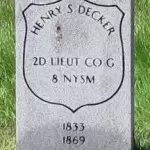
DECKER, HENRY S. (1833-1869). Second lieutenant, 8th New York Infantry, Company G. Decker was born in New York. After enlisting at New York City as a second lieutenant, he was commissioned into the 8th New York on April 23, 1861, and mustered out on August 2 of that year at New York City. The Mortuary Table for 1870 lists him as a clerk. He was a Freemason; members of his lodge were invited to attend his funeral. According to his obituary in the New York Herald, his death was due to a tumor. In 1893, Helen Decker, who is interred with him, received a pension, certificate 405,041. Section 190, lot 18207.
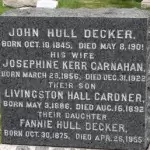
DECKER, JOHN HULL (1845-1901). Private, 102nd Pennsylvania Infantry, Company I. Decker, who was born in Pennsylvania, enlisted as a private on August 16, 1861, mustered into the 102nd Pennsylvania that day, and was discharged for disability on February 28, 1863. His application for an invalid pension was granted, certificate 290,230. He last resided at 175 Underhill Avenue in Brooklyn. He died from phthisis. Josephine Decker applied for and received a widow’s pension in 1901, certificate 530,446. Section 196, lot 30809, grave 2.
DECKER, REUBEN (1838-1901). First class fireman, United States Navy. Decker, a Brooklyn native, is listed as a smith in the 1857-1862 Brooklyn Directory; during those years, he lived on Oakland Street. He served as a first class fireman in the United States Navy during the Civil War. As per pension records, he enlisted on September 16, 1861, and was stationed on the USS North Carolina until September 30, 1861, when he was transferred to the USS Lancaster. A blacksmith by trade, he was 5′ 7½” tall with grey eyes, brown hair and a dark complexion. The Lancaster, a sloop-of-war, was one of six vessels that patrolled the Pacific from 1861 through 1866, both protecting commerce and mail steamers, maintaining peace, and looking for clandestine activity. A company of marines from the Lancaster were stationed at Mare Island, near San Francisco, California, as of March 14, 1862, and the vessel also sailed to Panama during the War.
Civil War Bio Search
Navy medical records for Decker state he was injured in the engine room on April 29, 1862, when his fingers were caught between two pieces of heavy machinery, but he suffered no fracture and returned to duty on May 2. He returned to the ship’s infirmary on June 24, 1862, with conjunctivitis of the left eye that, according to the surgeon’s “medical survey,” did not stem from his service. He was discharged to the Naval Hospital in Brooklyn on October 15 and admitted there on October 25. The records again affirmed that the condition did not originate in the line of duty. Decker was discharged from the hospital on March 9, 1863; the surgeon’s certificate declared him unfit for duty due to chronic conjunctivitis. His pension records indicate he was officially discharged in June 1863. Decker re-enlisted in September 1864, served on the USS Grand Gulf, and was discharged in October 1865.
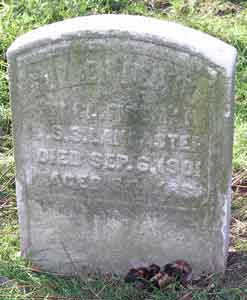
Decker is listed as a smith in the 1865 Brooklyn Directory and a machinist in the 1867-1870 Brooklyn Directory; he still lived on Oakland Street. He is reported as an engineer in the 1870-1873 Brooklyn Directory, as a seaman in the 1873-1876 Brooklyn Directory and as a smith in the 1877 New York City Directory. The census of 1880 lists him as a sailor.
He applied for an invalid pension in 1886, claim 10,881. Decker cited disease of the eyes, recording that in April 1862, while in San Francisco, California, and aboard the Lancaster, he contracted conjunctivitis from washing from the same bucket in which others washed and that has now lost the sight of his left eye and badley (sic) affected his right eye. He indicated on the affidavit that he was unable to work as a blacksmith and could only work as a laborer; Navy records disputed his claim as to the origin of his disease. An inscription on his gravestone confirmed his service aboard the USS Lancaster. His last residence was at 351 Sackett Street in Brooklyn but he died at the Kings County Almshouse. Section 3, lot 21025, grave 36.
DeCOSTA, ROBERT F. (1842-1875). Musician, 53rd New York Infantry, Company B. DeCosta, who was born in Massachusetts, was a clerk according to the census of 1860. According to the muster rolls, he was 5′ 4″ tall with blue eyes, brown hair and a fair complexion. He enlisted as a musician at New York City on August 31, 1861, mustered into the 53rd New York the same day, and mustered out on March 21, 1862, at Washington, D.C. As per the census of 1870, he was a store clerk. He last resided at 53 Broadway in Manhattan. According to records, he died of phthisis. Section 15, lot 17263, grave 27.
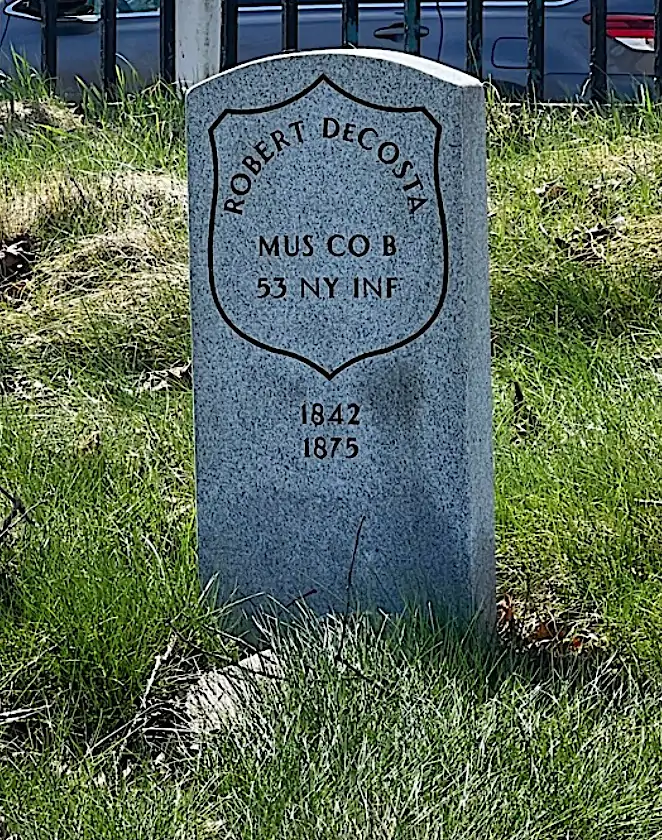
DEERING, JOHN (1830-1907). Private, 102nd New York Infantry, Company I. An Irish native, Deering served as a private in Company I of the 102nd New York according to his pension record. Further details are unknown. His last address was 171 West 81st Street in Manhattan. The cause of his death is listed as nephritis. In 1918, his widow was awarded a pension, certificate 871,634. Section 105, lot 2912.
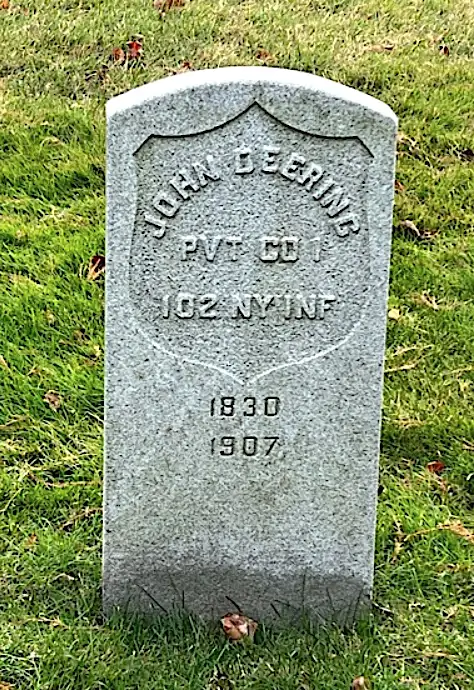
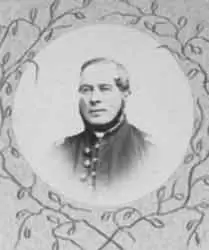
DEFENDORF, WILSON (1812-1891). Captain, 6th New York Heavy Artillery, Company K; 10th Veterans Reserve Corps, Company D. A New Yorker by birth, Defendorf was a cadet at the U.S. Military Academy from 1835-37 according to his pension record. As per the New York Directory for 1857, he had a stock brokerage, Defendorf & Co., at 125½ Bowery and lived in Tarrytown, New York. Also successful as a realtor, he purchased and enlarged a house along the Hudson River in Upper Nyack, New York, which dated to 1730 on a 14-acre property.
He enlisted as a captain at Yonkers, New York, on August 25, 1862, and was commissioned into the 6th New York Heavy Artillery, a regiment that he raised, on September 10. As per his obituary in the New York Sun, the regiment, after two months in Yonkers, went to Baltimore, where they camped at Stewart’s Mansion, then to Camp Wellington, and from there to Harpers Ferry for six months. They were then sent to Fort Reno, Maryland, and then to Warrenton, Virginia. That obituary notes that Defendorf was promoted to quartermaster, serving in that capacity for seven months before being sick from overwork and sent to Washington, D.C., for three months before his transfer to the Invalid Corps. His pension record also indicates service in Company K of the 135th New York but that unit, raised in August 1862, and known as the Anthony Wayne Regiment of Infantry, became the 6th Artillery as of October 2, 1862. He was transferred into the 10th Veterans on September 11, 1863, from which he was discharged.
As per an article on the Defendorf’s estate in the White Plains Journal News on September 4, 1975, Defendorf returned after his military service to the house with its new wing, decorated with the most handsome furnishings of the day. Among his Civil War mementoes that were included in the décor were his regiment’s battle flag, his discharge certificate signed by Ulysses S. Grant, and a panoramic map of the Battle of Gettysburg, where his regiment fought with distinction. His spurs and battle sword along with family bibles were also prominently displayed.
At the time he applied for a passport in 1871, he was 5′ 5″ tall, with blue eyes, dark hair, a florid complexion, small nose and mouth, round chin, and high forehead. Defendorf’s obituary in the New York Evening Post states that he was one of the wealthiest residents of Rockland County, raised Company K of the 6th New York, and had “a good record for gallant service.” A resident of Upper Nyack, New York, at the time of his death, Defendorf Lane there is named for him. In 1918, Mary Defendorf applied for and received a widow’s pension, certificate 874,139. At the time the aforementioned article about the Defendorf estate was written in 1975, the property was seven acres and was preserved and lived in by descendants. Section 109, lot 8249.
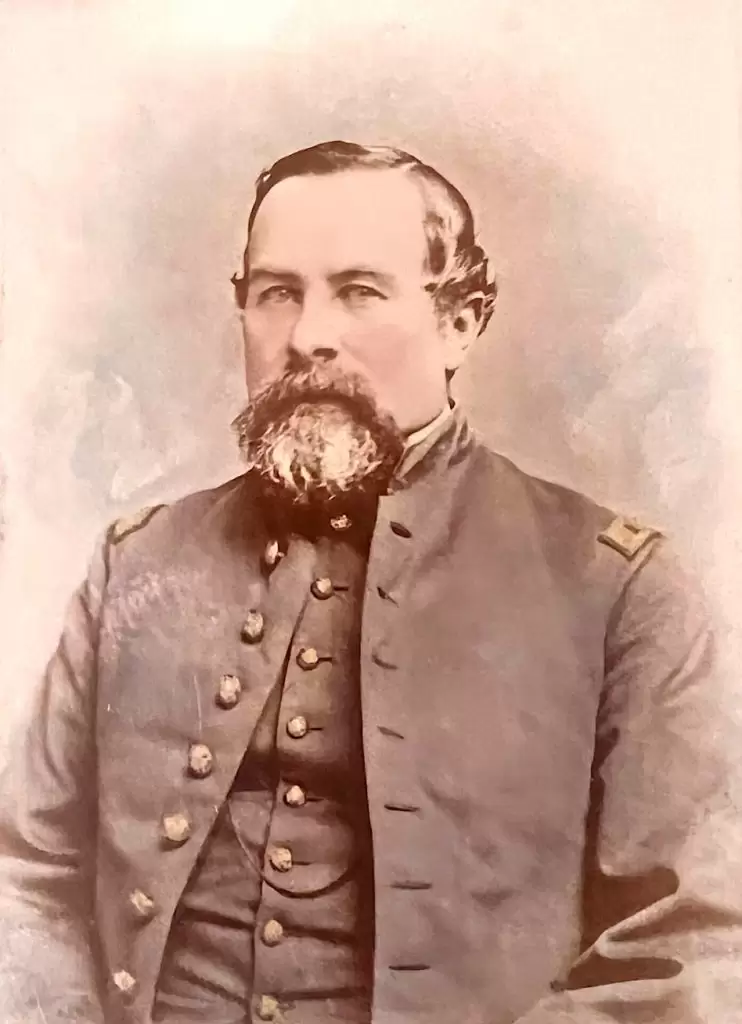
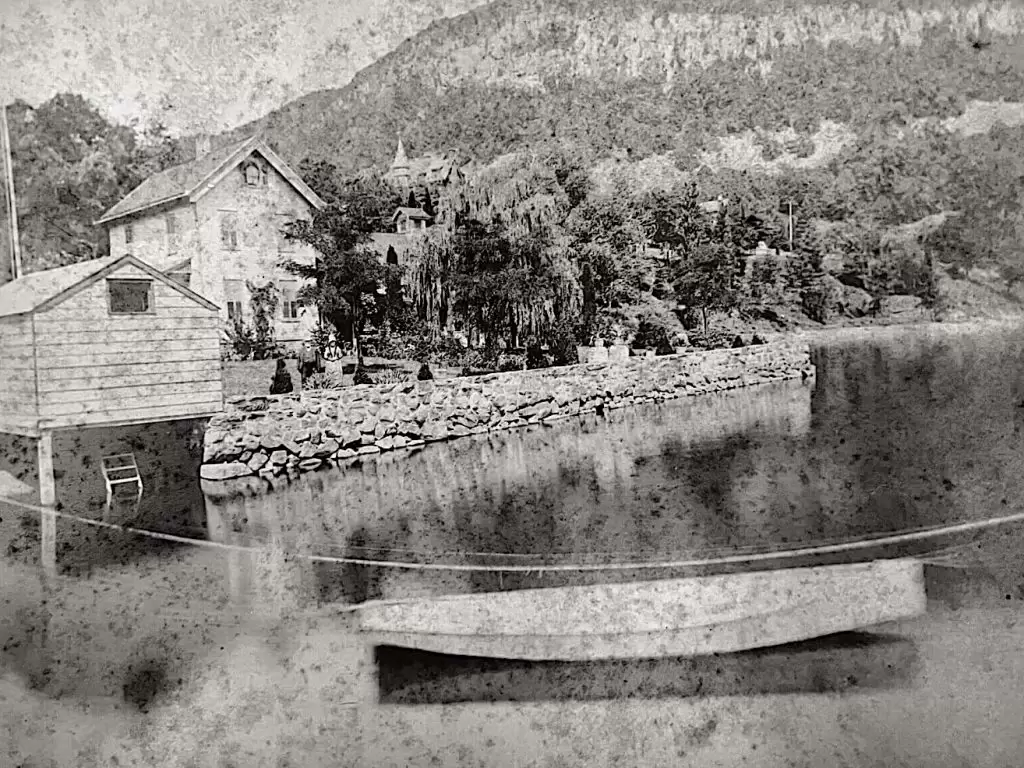
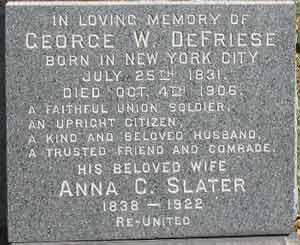
DeFRIESE (or DEBRIESE), GEORGE W. (1831-1906). Private, 5th New York Heavy Artillery, Company A. A native of New York City, the census of 1850 lists him as a silversmith. DeFriese enlisted as a private on August 15, 1864, at East Fishkill, New York, the same day that he mustered into the 5th New York Heavy Artillery. As per his muster roll, he was a teamster who was 5′ 5½” tall with blue eyes, black hair and a light complexion. He mustered out on June 22, 1865, at Harpers Ferry, West Virginia.
According to the New York City Directories of 1879 and 1891-1892 and the census of 1900, he was a silversmith. His pension application was approved in 1901, certificate 1,039,377. DeFriese last lived at 357 Quincy Street in Brooklyn. DeFriese died from pneumonia. His tombstone was inscribed in part, “A Faithful Union Soldier.” Anna C. Slater-DeFriese, his wife, who is interred with him, applied for and received a widow’s pension in 1906, certificate 620,136. Section 174, lot 17495, grave 3.
DEGHUEE, HENRY JOSEPH (1840-1883). Rank unknown, 13th Regiment, New York State Militia, Company D. Born in Germany, he enlisted on April 23, 1861, mustered into the 13th Regiment, and mustered out on August 6, 1861. He is likely the Henry Deghuee listed as working in segars (cigars) at 162 Montague Street in the 1864 and 1865 Brooklyn Directories. His last residence was 420 Bergen Street in Brooklyn. In 1909, Emma Deghuee applied for and received a widow’s pension, certificate 696,073. Section 108, lot 3355.
DeGROOT, GEORGE GORDON (1841-1865). First sergeant, 127th New York Infantry, Company D. DeGroot was born in Edinburgh, Scotland. In 1862, he married Elizabeth O’Neil Ryder; they had one daughter. DeGroot enlisted at Brooklyn on August 20, 1862, as a sergeant, and mustered into the 127th New York, popularly known as “the Monitors,” on September 8. The 127th was recruited principally from Long Island and New York City. The regiment first participated in the defense of Washington, D.C., then left for Suffolk, Virginia. DeGroot repeatedly wrote to his brother Nicholas during his service, recording his perspective on the Civil War and offering a window into his personality. He wrote on November 9, 1862, from Upton, Virginia: “Us boys tore down a nice house…to floor our tents with, also his barn. There was of course no owner and no one disturbed us. It looks a shame, but wood has got to come from somewhere.” The following three excerpts express his feelings: On November 19, 1862, from Falls Church, Virginia, “A soldier is Uncle Sam’s nigger, and it don’t much matter where or what they do with them.” On January 16, 1863, he wrote, “I have had some trouble with some of the NY roughs, but I get along now first rate.” And, on February 11, 1863: “Bill Murphy cut two of his fingers off with the axe. This is soldiering in reality.”
DeGroot’s letters continued to express his frustration as the fighting dragged on. On April 26, 1863, he wrote from Suffolk, Virginia:
We capture a few prisoners every day. One of the officers captured the other day (with the 6 pc artillery) said that it was a great feat to capture a few half-starving men, and what belong to us, as it seems the guns were captured from us at Bull Run….One house which the rebels kept in, our shells could hardly reach, and there was a 50-day furlough offered to the man that would burn it. It made a splendid fire last night so I presume somebody is lucky.
On May 19, 1863, he told his brother that his regiment was strict and that “I have been under arrest only once, 7 months ago for swimming across the Potomac.” In the wake of the Battle of Gettysburg, the 127th marched from Virginia to Frederick, Maryland, where he wrote to his brother on July 12, 1863, “All the men have either no shoes or no coat, some no hats and others hardly any pants….I wore no shirt at all up the peninsula.” In September 1863, the regiment headed to Charleston Harbor. He described Fort Sumter on September 9, 1863: “The rampart & fort looks more like a badly damaged cheese than old Sumpter (sic).” On October 15, 1863, he was promoted to first sergeant of his company. DeGroot wrote about the challenges related to his promotion which sometimes involved acting as orderly sergeant. He wrote on October 17, 1863: “I now have to make the men toe the mark or be reduced, and quite often risk my life in fights with them, as I have a rough company, and it takes a rough man to deal with them.” (He had previously written to his brother on March 20, 1863, “I am just the man to drill conscripts or niggers.”) His eagerness to fight was expressed in a letter to his brother on March 4, 1864, “To run a rebel through with a bayonet is fun and I could do it with a clearer conscience than I could killing a pig.”
His letters included descriptions of Fort Wagner and sketches including ones of his shanty at Coles Island on January 12, 1864, and of Fort Sumter on May 2, 1864. DeGroot’s first real action in battle came on July 31, 1864, in a failed amphibious assault on Fort Johnson, South Carolina. He wrote, “It looked like a much better chance for our lives & victory besides in landing than to row through their heavy fire against the tide, with the name of defeat besides.” After a Long Island newspaper was critical of the 127th in this assault, he wrote, “Some think of lynching the editor when caught.” Suffering from chronic health problems and several hospitalizations, he wrote, “I almost think at the rate I am losing strength, that David Jones locker will soon come.” He returned to the regiment in November 1864 after a furlough home. On December 29, 1864, 1864 he was badly wounded in action at DeVeaux’s Neck, South Carolina (also known as the Battle of Tulifinny), and died of his wounds on January 14, 1865, at the General Hospital in Hilton Head, South Carolina.
His obituary in the Brooklyn Daily Eagle on April 5, 1865, noted his death in South Carolina and extended an invitation to friends and family to attend his funeral. DeGroot was interred at Green-Wood on April 7, 1865; the funeral was held at the home of his parents at 147 Lafayette Avenue in Brooklyn. Elizabeth DeGroot applied for a widow’s pension on July 6, 1865. An archive of his letters and drawings was sold at auction in January 2016. Section 158, lot 16201.
DEGRUSHE (OR DEGRUSHI, DeGRUSHE), JOHN B. (1842-1908). Private, 145th New York Infantry, Company I; 107th New York Infantry, Company H; Veteran Reserve Corps. Degrushe, who was born in Westchester County, New York, was a printer at the time he entered service. He was 5′ 6″ tall with blue eyes, dark brown hair and a fair complexion. He enlisted at New York City as a private on August 14, 1862, and mustered into the 145th New York on September 11. Although his muster roll indicates that he was present as a corporal on April 10, 1863, there is no evidence of a promotion on his soldier records. Further, his muster roll states that he subsequently held the rank of private when he was sick in Carver Hospital at Washington, D.C., as of April 26, 1863; he was still in the hospital on August 29, 1863. He returned to the muster rolls when he was transferred into the 107th New York on December 9, 1863. He transferred into the Veteran Reserve Corps on February 11, 1864, from which he was detached to Company H of the 1st New York. On July 14, 1865, he mustered out at Elmira, New York.
As per the census of 1870, he was a letter carrier; the 1877 New York City Directory identifies him as a printer. The census of 1880 reports that he was a clerk in a store. In 1890, his application for an invalid pension was granted, certificate 881,488. The Brooklyn Directories for 1892-1894 and 1894-1896 list him as a collector living on South 1st Street. His last address was on Reid Avenue in Brooklyn. His death was caused by emphysema. In 1916, Adelaide Degrushe applied for a widow’s pension from Georgia, application 1,076,761, but no certificate number is indicated. Section 199, lot 28937, grave 1.
DE HAAS, MAURITS FREDERIK HENDRIK (1832-1895). Marine painter. Born in Rotterdam, Holland, he studied there and in The Hague, made sketches of English and Dutch coasts, then painted as artist to the Dutch Navy. His paintings of this period were mainly of the English Channel and the French coast; titles include Storm Off the Isle of Jersey and After the Wreck. He came to New York City in 1859 and settled there.
During the Civil War, De Haas painted several naval scenes for Admiral David Farragut, including Farragut’s Fleet Passing the Forts Below New Orleans. He was one of the original members of the American Society of Painters in Water-colors, and won renown for his coastal scenes. His paintings were exhibited at the National Academy of Design (of which he was a member), the Boston Athenaeum, and the Maryland Historical Society. He was a tenant in the Tenth Street Studio Building 1864-1895. Section 184, lot 27875.
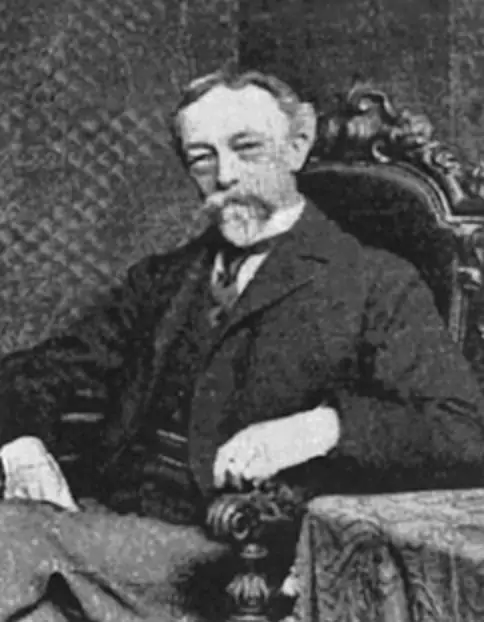
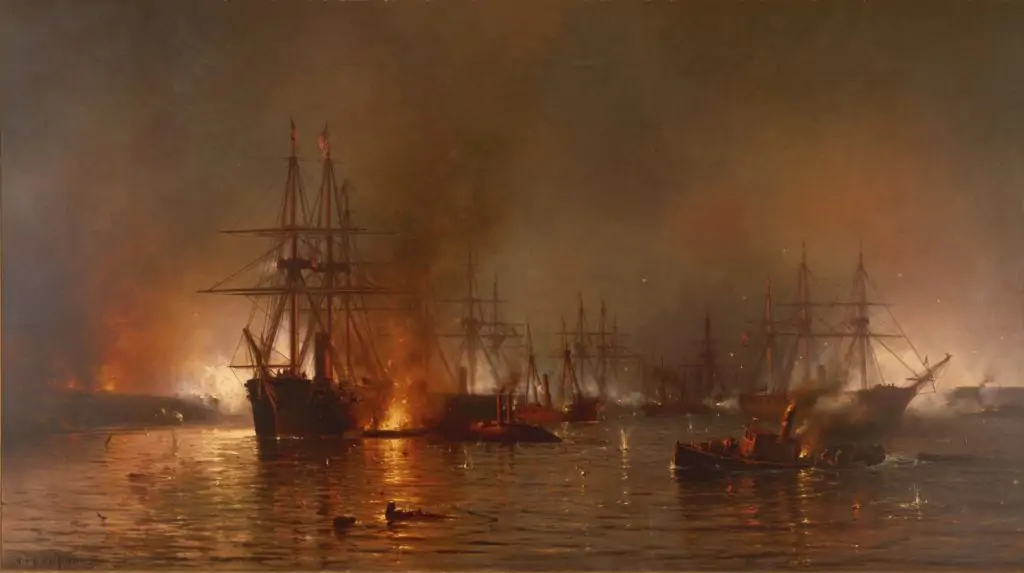
DeHANNE, JEAN VICTOR (1834-1904). Major and captain by brevet; assistant surgeon, United States Volunteers, Medical Staff; private, 176th New York Infantry, Company B. A New Yorker by birth, he enlisted at Brooklyn as a private on October 7, 1862, mustered into the 176th New York two months later on December 18, and was discharged for disability on September 22, 1863, at New Orleans, Louisiana. On December 21, 1864, he re-enlisted as an assistant surgeon and was commissioned immediately into the United States Volunteers Medical Staff, participated in General William T. Sherman’s March to the Sea and the burning of Atlanta, and served until May 28, 1867. On June 3, 1867, he was brevetted captain and major for “faithful and meritorious service.”
DeHanne subsequently served in the United States Army as an assistant surgeon until he retired on February 26, 1891. During that service, he was in Kansas at Fort Riley during the Indian Wars, and was at various Army posts in Kansas, Nebraska, Oklahoma (then Indian territory), and also served at Fort Mackinac, Michigan, and Fort Concho, Texas. DeHanne is identified as a surgeon in the 1894-1896 Brooklyn Directory; during those years, he lived at 486 7th Street. He last lived in White Plains, New York. His death was attributed to stomach cancer. His widow, Sarah Rowley DeHanne and one son survived him. Section 71, lot 826, grave 1.
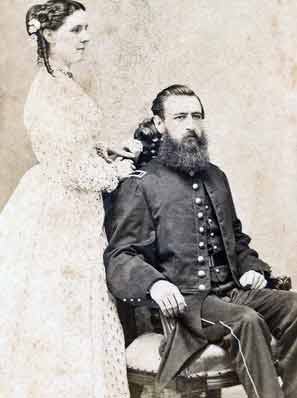
DEININGER, GEORGE C. (1840-1911). Private, 55th New York Infantry, Company I; 3rd Light Artillery United States Army, Company C. Born in Germany, Deininger immigrated to New York in 1846. He enlisted as a private at Staten Island on August 22, 1861, mustered into the 55th New York six days later, and was wounded in action at Williamsburg, Virginia, on May 5, 1862. After his discharge on December 10, 1862, he mustered into the United States Army’s 3rd Light Artillery, and was discharged on February 16, 1864, by reason of reinstatement at Stevensburg, Virginia. His muster roll for that enlistment states that he was a tinsmith who was 5’6½” tall with a dark complexion.
As per the censuses of 1870 and 1880 and the Brooklyn Directory of 1872 and 1882, Deininger was employed as a watchman. The Brooklyn Directory of 1888-1889 shows that he was employed as a laborer. He sought a pension in 1889, application 730,607, but there is no certificate number. His pension record indicates that he also served in Company A of the 13th New York but it is unclear when he served in that unit. The Veterans Census of 1890 confirms his service during the Civil War. It is possible that he is the George Deininger who is identified as a painter in the Brooklyn Directory for 1890-1892. On December 19, 1896, he became a naturalized citizen. In 1910, the census shows that he was working as a janitor. He last resided at 5020 Fifth Avenue in Brooklyn. Deininger died from nephritis. Emma Deininger, who is interred with him, applied for a widow’s pension in 1919, application 1,110,676. Section B, lot 11005, grave 18.
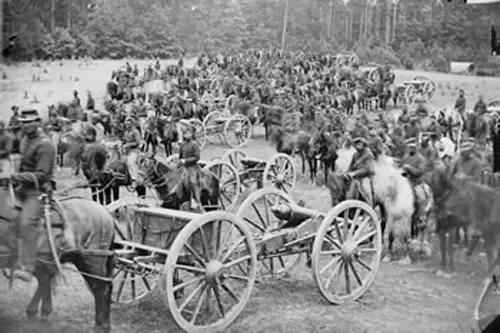
DeKAY, SIDNEY BROOKS (1845-1890). Major by brevet; first lieutenant, 8th Connecticut Infantry, Companies B and G; private, 71st Regiment, New York State National Guard, Company I. Born in New York, and the son of a Naval officer, George Coleman DeKay, Sidney DeKay first served for 30 days as a private in the 71st Regiment, New York State National Guard, in 1863. A year later, while a resident of New Haven, Connecticut, he enlisted as a first lieutenant on May 16, 1864, and was commissioned into Company B of the 8th Connecticut nine days later. Reporting from the field in Virginia, on January 8, 1865, Major General Benjamin Butler commended DeKay, aide-de-camp, for his cool courage and daring during the assault against Fort Fisher, North Carolina, on December 25-27, 1864. On March 13, 1865, he was brevetted to major. DeKay was transferred to Company G on July 1, 1865, and mustered out on December 12, 1865, at Lynchburg, Virginia.
The 1872 Brooklyn Directory lists DeKay as a lawyer; in 1874, he was the military secretary to Governor John A. Dix. An article in the New York Daily Graphic on November 6, 1876, states that he was a United States Commissioner (pre-cursors to federal magistrates) investigating the collision in December 1875 of the White Star Line’s ocean liner Adriatic and the Harvest Queen, a sailing vessel, in which all lives were lost aboard the latter vessel. He is identified as a lawyer living in Staten Island in the 1875-1876, 1876-1878, 1879-1880 New York City Directories, the census of 1800, and the Phillips’ Business Directory for 1881-1882. The Veterans Schedule of 1890 validates his military service in the Civil War; he then lived in New Brighton, Staten Island. According to the 1891-1892 New York City Directory, his law practice was at 115 Broadway, the same address as in all the directories after 1881.
According to his obituary in The New York Times, he was a member of the Loyal Legion, a fraternal organization of Union officers and later, their descendants, formed after the death of President Abraham Lincoln to thwart threats to national security; members of the organization were invited to attend his funeral. His brother, J. K. Drake DeKay was a captain and brevet lieutenant colonel of the 14th United States Infantry during the Civil War; his other brother, Charles DeKay, was the literary editor of The New York Times. He last lived in New Brighton, Staten Island. In 1908, Minna Craven DeKay, who is interred with him, applied for and received a widow’s pension, certificate 671,934. He was also survived by three children; two other children died as infants. Section 42, lot 41.
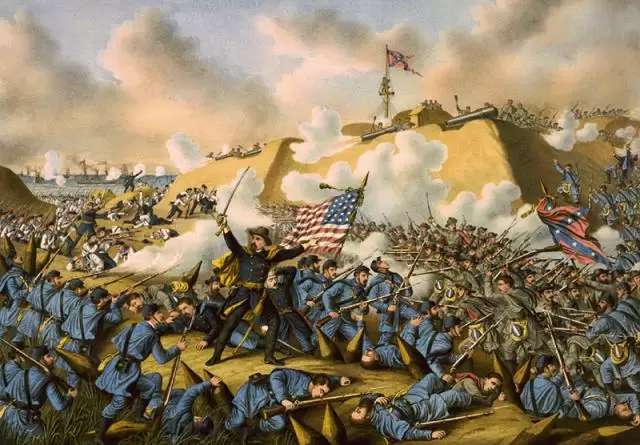
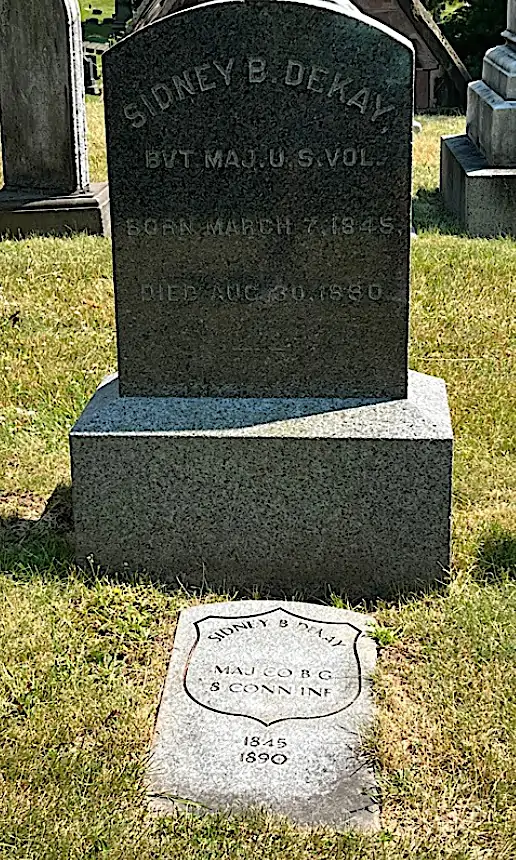
DeLACY (or DELACEY), WILLIAM (1828-1898). Brigadier general by brevet; colonel, 164th New York; major, 37th New York Infantry, Companies B and K. Originally from Essex, England, DeLacy enlisted at New York City as a first lieutenant on July 8, 1861, was commissioned into Company B of the 37th on that day and was promoted to captain and transferred to Company K on September 10 of that year. On May 5, 1862, he was wounded in battle at Williamsburg, Virginia. Upon his promotion to major on October 8, 1862, he was transferred to the Field and Staff. On May 8, 1863, commanding officer Colonel Samuel B. Hayman complimented DeLacy’s leadership at Chancellorsville, Virginia, when he wrote that he was “active in rallying his men, and sustained his well-earned reputation acquired in other scenes of strife…” He mustered out of the 37th at New York City the next month on June 22.
DeLacey continued his service when he was promoted to lieutenant colonel on November 3, 1863, and commissioned into the 164th New York’s Field and Staff. He was severely wounded in the left forearm at Spotsylvania Court House, Virginia, on May 18, 1864, was promoted to colonel on July 7, 1864, and returned to his regiment on August 20 of that year. He was brevetted brigadier general on March 13, 1865, “for gallant and meritorious services.” On March 25, 1865, he was severely wounded on the picket-line at Petersburg, Virginia. Brigadier General William Hays, United States Army, wrote about the injury in his field report three days later stating, “This is the third or fourth time this meritorious officer has been wounded during the War.” He mustered out on July 15, 1865, at Washington, D.C. By order of the Headquarters Department of the East, United States Army, dated April 23, 1865, he was named a member of the Guard of Honor detailed to stand near the body of the assassinated President Abraham Lincoln as it was put on view in the City Hall of New York City.
On July 7, 1866, his application for an invalid pension was granted, certificate 75,791. DeLacy became a naturalized citizen on October 25, 1867. The census of 1870 states that he worked at the U.S. Custom House; the New York City Directory for 1877 and the census of 1880 indicate that he was a printer. The 1880-1882 Brooklyn Director shows that he was an assessor at the Municipal Building and a printer on John Street in Manhattan; during those years, he lived at 360 Dean Street in Brooklyn. He is also listed as a printer in the Phillips’ Business Directory for 1881-1882. As commander of his local G.A.R., he attended a meeting at the St. James Hotel to raise money to fund a home for ex-Confederate soldiers in Richmond, Virginia. According to the article in the New York Herald on April 6, 1884, a performance of Richard III would be held at the Metropolitan Opera for that purpose.
As per his obituary in the Sag Harbor Express, DeLacy served as an assessor for many years and was the chief clerk at the Key West Naval station at the time of his death; the obituary also confirmed his service in the Potomac region during the Civil War and his war wounds. His last residence was in Maplewood, New Jersey, where he died of gangrene. Maria Wilcox DeLacy, who is interred with him, applied for and received a widow’s pension in 1899, certificate 503,404. He was also survived by their daughter; his adult son predeceased him. Section 147, lot 23222, grave 6.
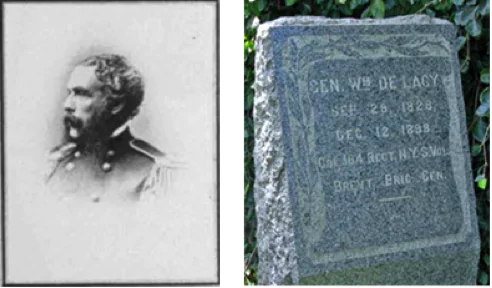
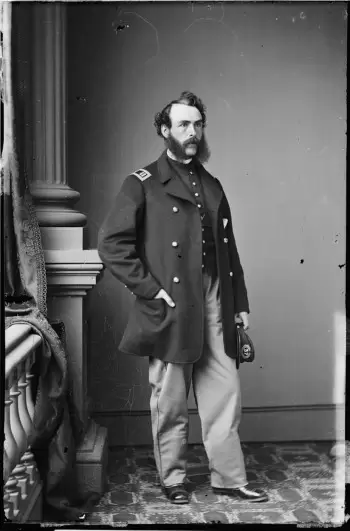
DELAFIELD, RICHARD (1798-1873). Major general by brevet; brigadier general, United States Army. Born in New York City, and one of fourteen children, Delafield graduated first in his class of twenty-three from the United States Military Academy, class of 1818. As a West Point cadet in 1815, he was detailed as an acting assistant professor of mathematics. Commissioned as a lieutenant into the Corps of Engineers, he was one of the topographical engineers assigned to establish the northern boundary under the Treaty of Ghent which was signed after the War of 1812. He was then an assistant engineer for the construction of the defenses at Hampton Roads, Virginia (1819-1824), was in charge of surveys in the Mississippi delta region until 1832, and then designed the first cast-iron tubular arch bridge in the United States when he was superintendent of repairs on the Cumberland Road east of the Ohio River. Appointed superintendent of the Military Academy in 1838, he designed the new buildings and cadet uniforms with a distinctive castle insignia. He also introduced equestrian exercises at the Academy, giving cadets training for both the infantry and cavalry.
Delafield was in charge of the construction of the coast defenses for New York Harbor from 1846-1855, where he superintended the building of Fort Richmond (later renamed Fort Wadsworth). He traveled to Europe with Major Alfred Mordecai and then Captain George B. McClellan to observe military operations there, was a military observer at the Siege of Sevastopol during the Crimean War, and then returned to his position as superintendent of the Military Academy from 1856 into 1861. His report on the aforementioned study trip, Report on the Art of War in Europe in 1854, 1855 and 1856 was suppressed during the Civil War because of fears that it would be useful to Confederate engineers due to its inclusion of drawings and descriptions of military fortifications.
During the Civil War, Delafield was a lieutenant colonel beginning August 6, 1861, was promoted to colonel on June 1, 1863, and was Chief of Engineers, United States Army, with the rank of brigadier general, from April 22, 1864, upon the death of General Joseph Totten. Early in the war, Delafield, an adviser to Edwin D. Morgan, New York’s governor and a Union Army general, helped equip and send volunteers from New York to the Union Army as and was subsequently in command of defenses around New York Harbor from 1861 until April 1864. As per Cullum’s Register, a biographical encyclopedia of West Point graduates, Delafield supplied ordnance stores for the Atlantic and Lake defenses, was superintending engineer of the defenses at the Narrows entrance to New York Harbor, the fortifications at Governor’s Island, New York, and Sandy Hook, New Jersey. After the Civil War, he returned briefly to the United States Military Academy, serving until his retirement on August 8, 1866. He continued to be a member of the Commission on Encroachments of the Ocean at Sandy Hook, New Jersey, from February 20, 1864, through June 30, 1867. On March 13, 1865, he was promoted by brevet to major general for meritorious services in the Engineer Department.
After his retirement from the military, he worked in engineering and served on two commissions related to improvements to Boston Harbor as well as to lighthouses. Delafield was also a regent of the Smithsonian Institution and a member of the Lighthouse Board. He died in Washington, D.C. His death was attributed to asthenia (abnormal loss of energy). The War Department noted his extensive lifetime achievements and concluded, “…As a tribute to his memory, the officers of the Corps of Engineers will wear the usual badge of mourning for thirty days, and the day after the receipt of this order, at West Point and Willet’s Point (an Engineer depot established by him), thirteen minute guns will be fired, beginning at noon, the national flag being displayed at half-staff during that time.”
Rufus Delafield’s (see) uncle, he was survived by his wife, Harriet Baldwin Covington Delafield whom he married in 1833, and five children; his first wife, Helen Summers, whom he married in 1824, died four months after their marriage. A collection of his letters, most addressed to General Joseph Totten, Chief of Army Engineers, dating 1846-1849, is housed at Syracuse University’s Library. Section 36, lot 3977.
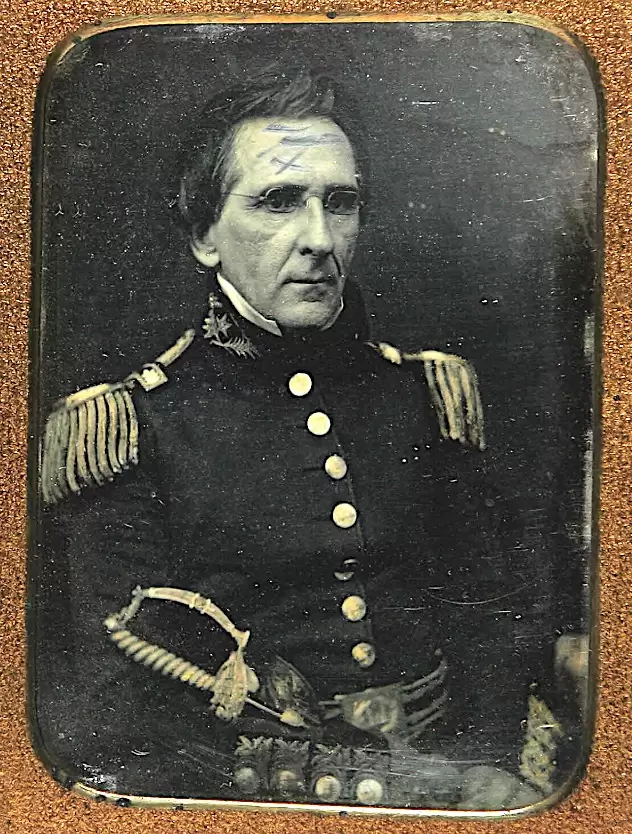
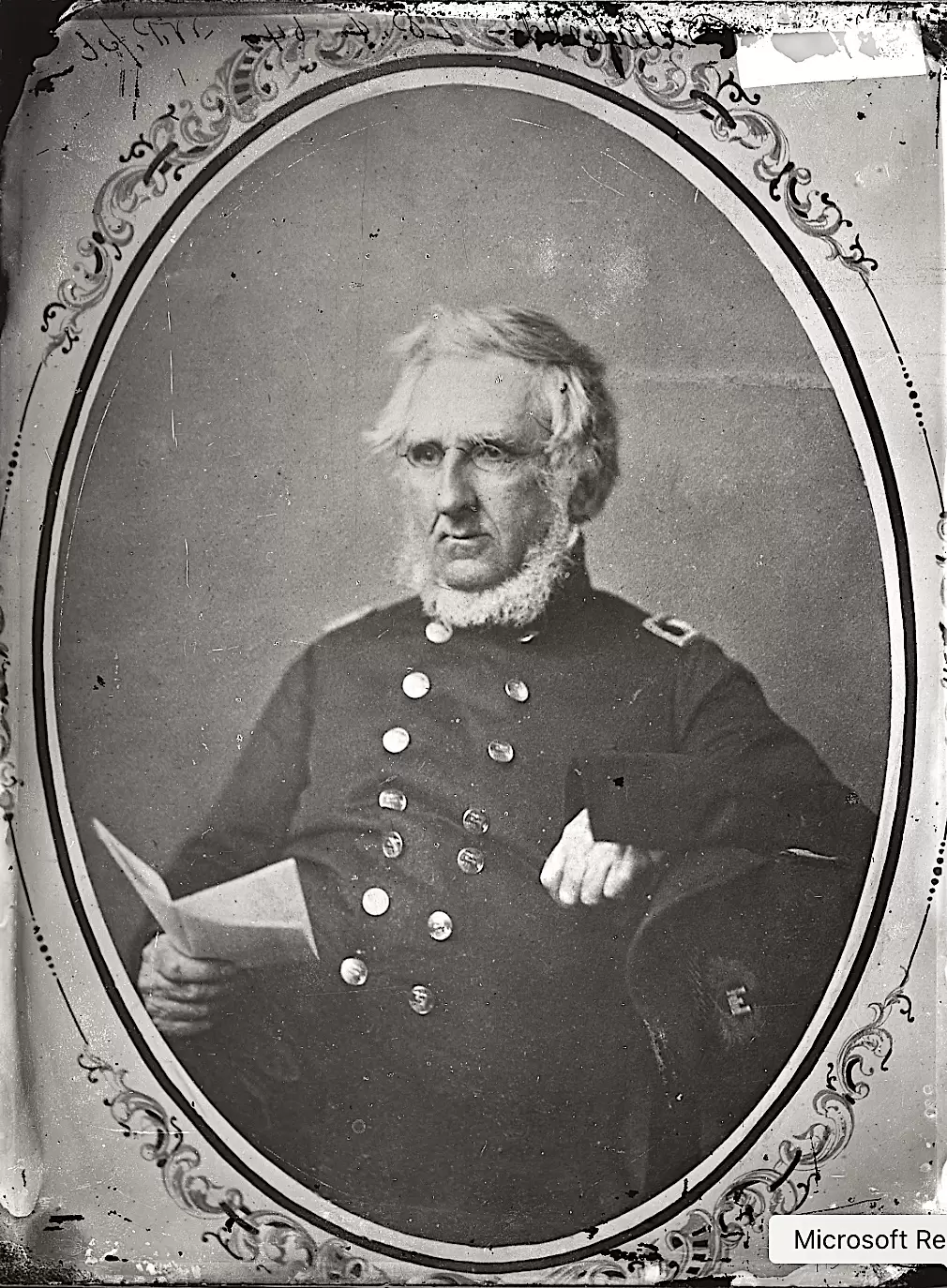
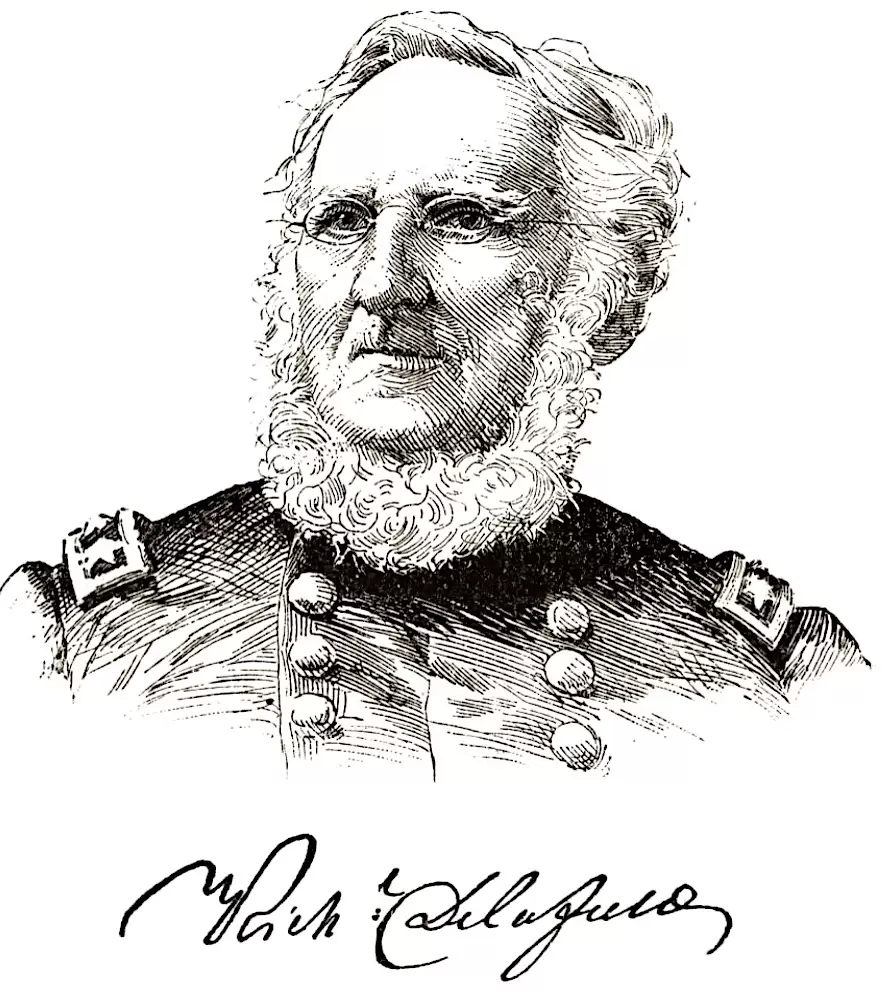
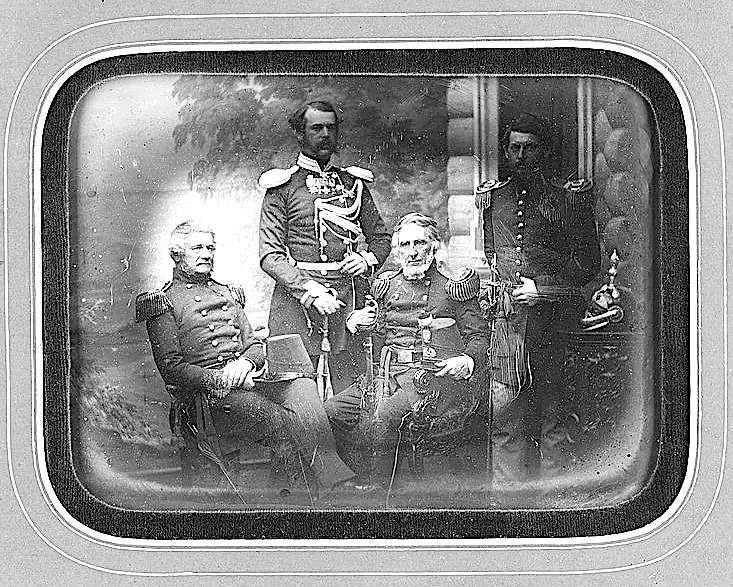
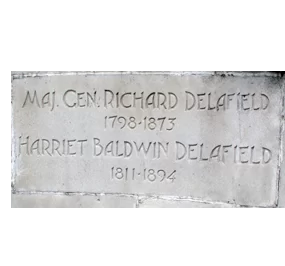
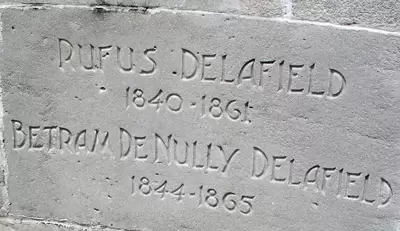
DELAFIELD, JR., RUFUS (1840-1861). Medical cadet, United States Army. Delafield, a native of New Brighton, Staten Island, and the nephew of Richard (see), served as a medical cadet in the Regular United States Army. His father was a prominent banker and founder of a hydraulic cement company. Rufus Jr. died on December 28, 1861, in Alexandria, Virginia, of typhus fever, and was interred at Green-Wood three days later. His family’s residence is now the site of the Staten Island Cricket Club. Section 36, lot 3977.
DELAN (or DELAND, DELEN, DeLAND), LEWIS (or LOUIS) P. (1836-1905). Acting ensign, United States Navy. A native of the Danish West Indies (his family traced their roots to France), his 1863 Draft Registration, filed under the name Louis Delen, indicates that he was white, married, lived in Manhattan and worked as a clerk. Delan enlisted as an acting ensign in the United States Navy on November 1, 1864. He resigned on April 12, 1865.
In 1866, he was living at 106 Bowery when he offered a reward for papers and a secretary desk that he had lost while moving. The 1870 census reports that he lived in Manhattan with his wife Annie and children and worked as a bookkeeper; the 1873-1876 Brooklyn Directory identifies him as a bookkeeper who lived at 1066 Pacific Street. Goulding’s Manual and General Statistical Guide for 1875, the 1894-1896 Brooklyn Directory and the 1897-1899 New York City Directory report that he was a clerk; at the time of the last named directory, he lived at 332 West 36th Street.
A chess enthusiast, Delan wrote to the New York Sun in 1882 concerning moves to be made on a sample game. Interested in social issues, Delan was the “worthy conciller” of the Carpet and Furniture Employees’ Social and Benevolent Association in 1886, and placed a notice thanking employers who agreed to close their stores at 7:00 p.m. rather than remaining open later. In addition, he was elected as a delegate to the Union Labor Party’s national convention in 1888. The 1900 census reports that he lived at 216 East 85th Street in Manhattan with Mary, his wife of three years, and worked as a fur salesman; that census indicates that he had been in the United States for 50 years.
He died in Brooklyn. As per his will, filed in Kings County Surrogate Court under the name Louis P. Deland, he last lived at 442 Cleveland Street in Brooklyn, with his wife Mary. He died “by accident” and owned no personal property or real estate at the time of his death. Section 183, lot 23923.
DELANO, WILLIAM H. (1832-1876). Sergeant, 176th New York Infantry, Company E. A New Yorker by birth, he enlisted there as a private on August 28, 1863, and mustered immediately into the 176th New York. He was promoted to corporal on April 1, 1864, and to sergeant on May 1, 1865. On April 27, 1866, he mustered out at Savannah, Georgia. The New York City Directory for 1868 lists him as a clerk; as per the 1870 census, he was a bookkeeper. Delano last lived at 314 West 28th Street in Manhattan. The cause of his death was consumption. Section 53, lot 4180.
D’ELOM (or DELOM), ALEXANDER (1832-1899). Second lieutenant, 139th New York Infantry, Companies A and K. Born in Italy, he enlisted at Brooklyn as a sergeant on August 15, 1862, and mustered into Company A of the 139th New York on September 9. On March 15, 1863, he was promoted to first sergeant. Transferred to Company K of the same regiment on October 18, 1863, he was simultaneously promoted to second lieutenant. Discharge was for disability on September 26, 1864.
He likely is the Alexander D’Elom who is listed in the candies business in the 1866 Brooklyn Directory. He successfully applied for an invalid pension in 1879, certificate 192,095. According to an article in the Brooklyn Daily Eagle on January 9, 1890, D’Elom was installed as officer of the day at the annual ceremonies of the Rankin Post #10 of the G.A.R. which was held at Saengerbund Hall in Brooklyn; membership totaled 325 comrades. In 1897, the New York State Senate, in its report on the Grand Army of the Republic, noted that D’Elom, an assistant inspector of Kings County, would inspect Post #286. As per Trow’s Directory for 1899, D’Elom was president of the 139th Veteran Association. At the time of his death, he resided at 1188 St. Marks Avenue in Brooklyn. His wife, Eugenie, died in 1898. Section 205, lot 30205.
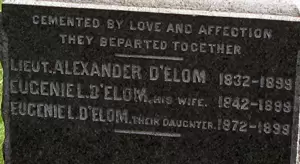
DELP, CHARLES (1834-1896). Seaman, United States Navy. Of English birth, Delp was a leather dealer living in Brooklyn according to the 1860 census. He joined the United States Navy in 1861, but there are no further details about his service. On June 25, 1892, he became a member of the Grand Army of the Republic, and was listed in the 1897 G.A.R. Journal under “Stars & Stripes, Navy.” His last residence was 73 Gates Avenue in Brooklyn. Section 183, lot 19373.
DELUCCA, PIERRE D. (1843-1895). Private, 15th Connecticut Infantry, Company G. Delucca was a native of France. According to the Grand Army of the Republic’s mortuary table for 1895, he served as a private in the 15th Connecticut. Other details of his military service are unknown. He became a member of the G.A.R. in January 1888. According to the New York City Directory for 1894, where he was listed as Peter Delucca, he was in the liquor business at the same address where he lived, 243 West 29th Street in Manhattan. Section 135, lot 27263, grave 2218.
De LUCE, EDMUND S. (1828-1890). Chief engineer, United States Navy. Born in New York City, De Luce joined the Navy on September 22, 1849, as a third assistant engineer, and was promoted several times over the next ten years: to second assistant engineer on February 26, 1851, first assistant engineer on May 21, 1853, and chief engineer on October 12, 1859. De Luce retired on December 13, 1878. He last lived on Adelphi Street in Brooklyn. Section 141, lot 24745.
DEMAREST, ALBERT A. (1844-1892). Corporal, 1st Battalion Engineers, United States Army, Company A. A native of New Jersey, Demarest served as a corporal in Company A of the 1st Battalion Engineers, United States Army. Further details of his service are unknown. It is possible that he is the Albert A. Demarest who is identified as a carrier in the 1876-1878 and 1882-1883 New York City Directories. His last residence was in Cherry Hill, New Jersey. He succumbed to apoplexy. Section 68, lot 2126.
DEMAREST, DANIEL (1838-1937). Private, 22nd Regiment, New York State National Guard, Company I. Born in New York City, he enlisted as a private at New York City on May 31, 1862. On June 18, he mustered into Company I of the 22nd Regiment and mustered out on September 5 at New York City.
As per the census of 1870 and the New York City Directory of that year, he was employed as a mason. He is also identified as a mason in the 1875-1876, 1876-1878, and 1881-1882 New York City Directories; in the last named directory, he is listed as living at 217 Bleecker Street. The 1890 Veterans Schedule for New York City confirms his Civil War service. Demarest is listed as a builder in the 1891-1892 New York City Directory. The census of 1900 indicates that he was living in Verona, New Jersey, and was employed as a mason; the census of 1910 shows that he had retired. He applied for and received a pension in 1905, certificate 1,119,512.
On May 28, 1937, an article in The New York Times, recognized Demarest’s longevity on his 99th birthday and quoted his secret, “Drink good whisky, eat meat and potatoes and smoke good cigars if you want to be as old as I am.” He also said that although he could walk several miles, he did not march in Memorial Day parades because it was “show-off stuff.” Both that article and his obituary in August 1937 stated that he was a building contractor and had been a New York City volunteer fireman. According to a descendant, Daniel, Martin (see), and William (see) Demarest were relatives. His last residence was 32 South Prospect Street in Verona, New Jersey. The cause of his death was organic heart disease. Section 168, lot 17422.
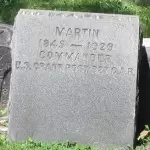
DEMAREST, MARTIN (1845-1929). Private, 21st New Jersey Infantry, Company F. Born in New York City and a resident of Hoboken, New Jersey, he enlisted on August 23, 1862, and mustered into the 21st New Jersey on September 15. Shortly after he enrolled, Demarest was appointed colonel’s orderly, and remained in that position for the duration of his service. He participated in the Battles of Fredericksburg and Chancellorsville (both in Virginia) and in Hooker’s reconnaissance force across the Rappahannock at the time of Lee’s invasion of Pennsylvania. He was discharged on June 19, 1863, at Trenton, New Jersey, at the expiration of his service.
After the War, Demarest moved to Brooklyn in 1874 and worked as a bookkeeper and cashier with an importing house. The 1870-1873, 1873-1876 and 1884-1886 Brooklyn Directories note that he was a bookkeeper; in the last named directory, he was living at 193 Ryerson Street. A member of the Ulysses S. Grant Post #327 of the G.A.R., he served on the relief detail at Albany, New York, after President Grant died. According to a descendant, Daniel (see), Martin, and William (see) Demarest were relatives. His application for an invalid pension was granted, certificate 1,068,899. His last residence was 149 Willow Street in Brooklyn. Demarest died from cardiac arrest. Section 77, lot 2813.
DEMAREST, PETER A. (1840-1869). Private, 8th Regiment, New York State Militia, Company I. New Jersey-born, Demarest enlisted as a private at New York City in 1861, mustered into the 8th Regiment when it was activated that year, and mustered out at New York City after three months. As per the U.S. Mortality Schedule for 1870, he had been a cartman. His last residence was 62 Charlton Street in Manhattan. His death was attributed to diabetes. Section 158, lot 14569.
DEMAREST, WILLIAM CAMPBELL (1838-1869). Private, 2nd New Jersey Cavalry, Company A. Born in New York, he enlisted as a private on August 4, 1863, and mustered into Company A of the 2nd New Jersey Cavalry on August 11. He deserted at St. Louis, Missouri, on November 18, 1864. As per the 1870 U.S. Mortality Schedule, he had been a clerk. According to a descendant, Daniel (see), Martin (see), and William Demarest were relatives. He last lived at 110 West 38th Street in Manhattan. His death was attributed to “laryngitis.” Section 118, lot 5006.
DEMING, WILLARD (or WILLIAM) F. (1826-1883). Assistant surgeon, 128th New York Infantry. On July 29, 1863, Deming enlisted as an assistant surgeon at New Orleans, Louisiana, was commissioned into the Field and Staff of the 128th New York on August 1, and was discharged for disability on June 5, 1864. Census records listed his occupation as a physician. In 1873, his application for a pension was granted, certificate 262,430. His widow, Emma Louis Deming, who is interred with him, received a pension, certificate 209,794. Originally interred at Cyprus Hills Cemetery after his death on April 14, 1883, he was re-interred at Green-Wood on October 19 of that year. Section 199, lot 24438.

DeMONTEIL, JOSEPH ANTONIE (or ANTOINE JOSEPH) VIGUIER (1819-1862). Lieutenant colonel, 53rd New York Infantry. Born in France, he served as an officer in France’s Marine Artillery, then came to America in 1853. A resident of 166 East 33rd Street in Manhattan, he enlisted as lieutenant colonel at New York City on August 16, 1861, and was commissioned into the 53rd (D’Epineuil’s Zouaves) on October 15. Shortly after his commission, he was court-martialed, but the charges were not proven and he was ordered to return to duty. DeMonteil was killed in battle on February 8, 1862, at Roanoke Island, North Carolina.
His commanding officer at Roanoke Island, Brigadier General John G. Foster, United States Army, wrote of his valor there on February 9, “I would mention that [Joseph Antonie Viguier] De Monteil, lieutenant-colonel of the Fifty-third Regiment, came up during the action and asked permission to fight as a private. This I granted, and he passed on in front to the position of the Tenth Connecticut, where he stood coolly aiming and firing his rifle and exhibiting the most marked bravery. He fell shot dead toward the close of the engagement…” Brigadier General John G. Parke, the commanding officer of the Third Brigade, also praised him in his report of February 9, “…he was killed instantly, while urging my men to the charge. He dies greatly lamented by all my officers and men who came in contact with him. His bravery was as great as his patriotism was sincere, and I cannot but feel that had he lived he would have proved a most valuable officer…”
His obituary in The New York Times included this quotation: “There is something truly touching in the manner of his death. When the order to charge was given, he ran at the head of the column until the fatal bullet came which instantly deprived him of life. Even in this dying moment, amid the triumphant shouts and steady rush of the charge, his soldier’s instinct, we gladly believe, told him that victory was assured.” He was interred at Green-Wood on March 15, 1862. His widow, Marie Justine DeMonteil, was awarded a pension. Section 11, lot 13784.
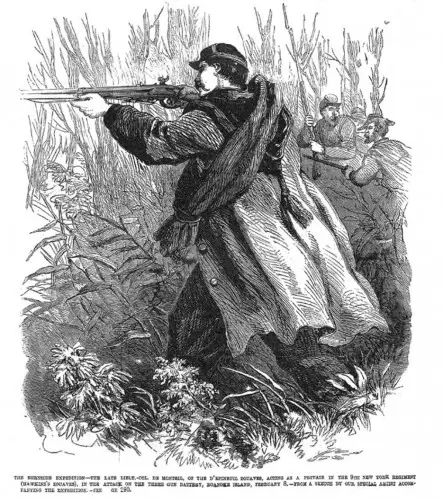
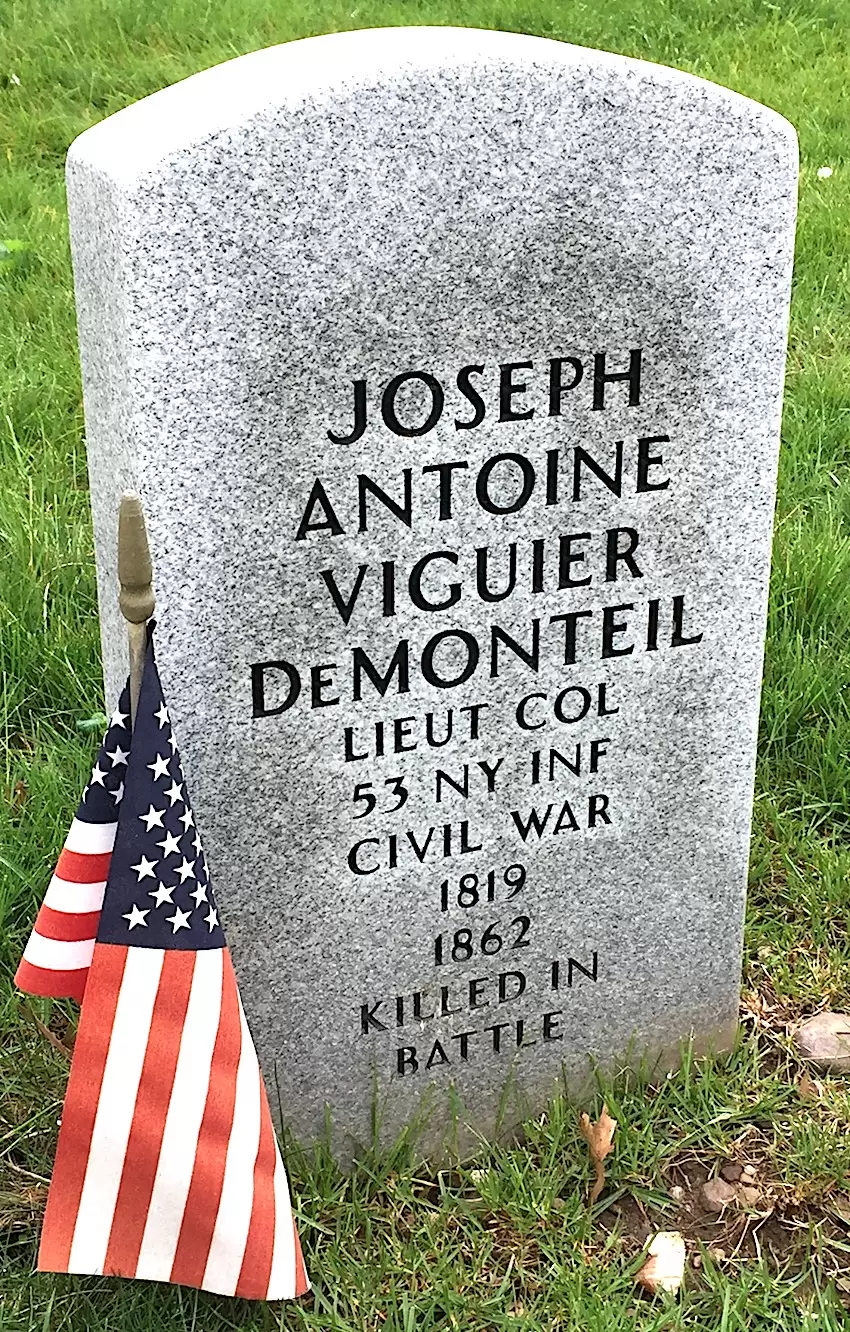
DeMOTT, ABRAHAM W. (1834-1900). Corporal, 139th New York Infantry, Company H. A native of Long Island, on August 21, 1862, he enlisted at Brooklyn as a corporal, and mustered in on September 9. He was reduced to private on January 24, 1863, and was discharged for disability on August 30, 1864, at Fort Schuyler in New York Harbor. On January 23, 1865, he applied for and received an invalid pension, certificate 330,440.
As per the census of 1870 and the 1873-1876 Brooklyn Directory, he was a blacksmith; in the latter directory, he lived at 118 Adelphi Street. The 1880 census indicates that he was a messenger. The 1894-1896 Brooklyn Directory identifies him as a laborer and the 1896-1898 Brooklyn Directory and the 1900 census report that he was a blacksmith; during those years, he was living at 135 Clermont Avenue, his last residence. His wife, Almira DeMott, applied for and received a widow’s pension, certificate 510,222. Section 136, lot 28307, grave 465.
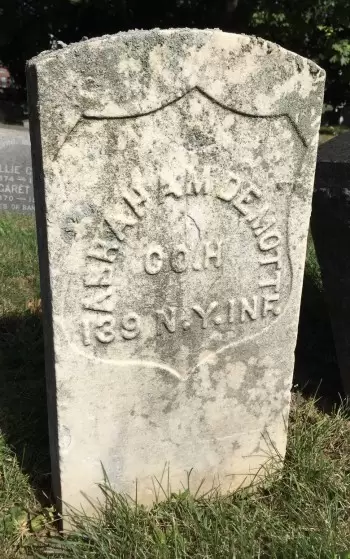
DeMOTT, CHARLES (1846-1931). Drummer, 22nd Regiment, New York State National Guard, Company B. Born in New York City, DeMott enlisted there as a drummer on May 28, 1862, mustered into the 22nd that day, and mustered out after three months at New York City on September 5. His application for an invalid pension was approved in 1908, certificate 1,150,649. He last lived on East 5th Street in Brooklyn. DeMott died of cardiac arrest. Section 80, lot 6000.
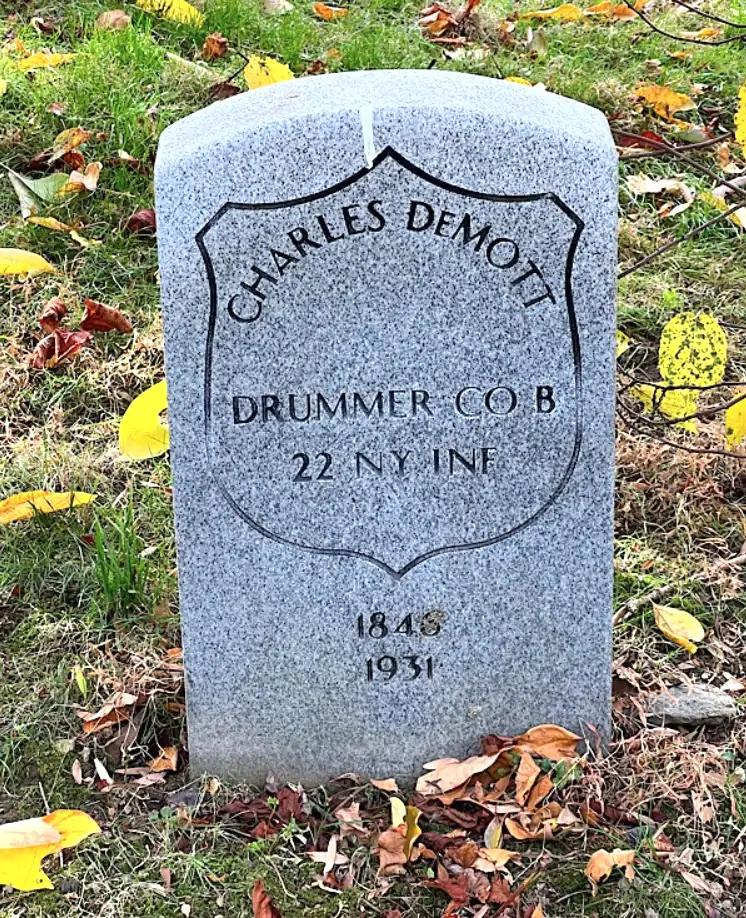
DEMUND (or DeMUND), JAMES HENRY (or J.H.) (1824-1869). Captain, Confederate Provisional Army; fourth sergeant, Chatham Artillery (Georgia); Chatham Light Artillery, Company C, Confederate States of America. Demund was born in New York. On August 14, 1847, he married Sarah H. Laughlin in Manhattan. The 1850 census reports that he was married with one young child, lived in Franklin, Florida, and worked as a cotton agent. At the time of the 1860 census, he lived in Savannah, Georgia, with his wife and children, worked as a superintendent of a cotton press and had a personal estate valued at $15,000. The Georgia Muster Rolls for the Civil War indicate that he mustered into the Chatham Artillery in that county as a 4th sergeant on April 30, 1861. In 1862, his unit was referred to as Captain Van Den Corput’s Company and Captain Wheaton’s Company, Artillery. He also served in Company C of the Chatham Light Artillery. His soldier record indicates that he enlisted as a captain on an unknown date and had service in the Confederates States of America Gen. & Staff. His descendant notes that he was commissioned captain, assistant commissary, in October 1863 and June 1864, and served with the 1st Infantry, Olmstead’s and Claghorn’s Companies.
At the time of his death, he was working at a cotton press; he died from consumption. As per his obituaries in the Savannah Republican and the Atlanta Constitution, where he was referred to as Captain DeMund, he died in New York at the home of his sister and was a resident of Savannah for many years. His daughter, Maria Matilda Demund married Abram Allen (see). Section 52, lot 6295.
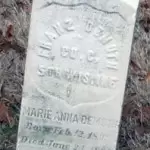
DEMUTH, FRANZ (or FRANCIS) (1841-1862). Private, 5th Wisconsin Infantry, Company C. Originally from Bohemia, his family immigrated to the United States in 1858 with his family. As per the passenger list, his father, Anton Demuth, was a glassblower. According to the census of 1860, Anna Demuth, his mother, who was head of the household, was a glassblower with a personal estate of $200. The same census indicates that Franz was an apprentice mechanic. Demuth enlisted as a private at Milwaukee, Wisconsin, on April 21, 1861, mustered into the 5th Wisconsin on that date, and died from typhus fever at his home on November 28, 1862. His mother, Marie Anna Demuth, applied for and received a pension on February 16, 1863, certificate 34,032. His last address was in North William, New York. A government-issued headstone was provided for him circa 1900. His brother, Adolph Demuth, who was a part-owner of Quezal Art Glass & Decorating Co. in Brooklyn, founded in 1902, patented a glass mouthpiece for cigars and cigarettes in 1881. Section 103, lot 4475.
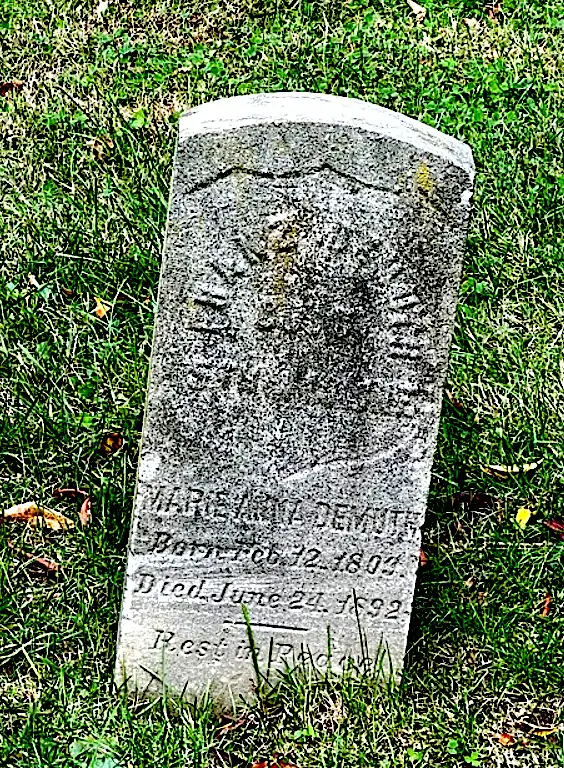
DENECKE, FREDRICH (or FREDERICK) (1832-1869). Unknown soldier history. As per the New York City Directory for 1857, Denecke was in the shoe business. According to his obituary in The New York Times, he served with the 7th Regiment, New York State National Guard though it is unclear whether that service occurred during the Civil War. The 1868 New York City Directory lists him as a hotelier. His last residence was 708 3rd Avenue in New York City. Congestion of the brain was listed as his cause of death. Section 121, lot 12579.
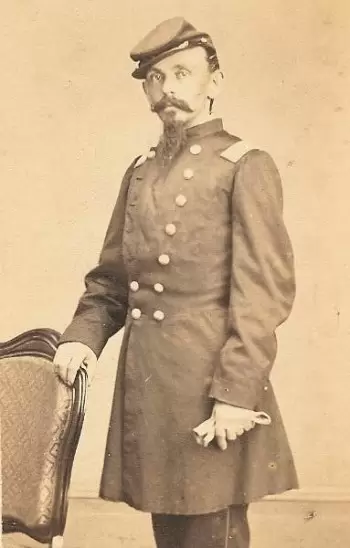
DENGLER, ADOLPH (or ADOLF) (1824-1885). Colonel, 43rd Illinois Infantry; captain, 3rd Missouri Infantry, Company I. Originally from Baden, Germany, he fought against the Prussians in 1848, being second in command of the revolutionary forces. Although there was a bounty on his head, he falsified his death to escape the secret police in 1850 and came to New York on board the Minnesota, a ship that departed from Liverpool, England. In New York, he led a workers’ strike in a textile factory in 1852. In 1860, he lived in Belleville, Illinois, southeast of St. Louis, with his wife, two children and his mother-in-law and was employed as a hat and cap maker.
During the Civil War, he helped organize the two regiments in which he fought. He enlisted on April 28, 1861, mustered into the 3rd Missouri at the St. Louis Arsenal on May 27, and mustered out after three months on September 4. That regiment, also known as Franz Siegel’s German Regiment, saw action at Carthage and Wilson’s Creek, Missouri. Dengler then re-entered service as a major on September 9, 1861, and was commissioned into the Field and Staff of the 43rd Illinois (a German-American regiment also known as the Koerner Regiment) on December 16 of that year. His regiment fought at the Battle of Shiloh, Tennessee, in April 1862. In Dengler’s battle report from Bolivar, Tennessee, dated December 28, 1862, he wrote of the engagements on December 18-27 near Jackson, Tennessee, during which only two of his troops were slightly wounded:
…Slowly at last they came in view, advancing cautiously for the first 100 yards, then putting their horses in a brisk trot till within 150 yards of us, when amid deafening cheers they charged headlong down the road upon us. My men, however, had been cautioned to reserve their fire. I let the enemy advance till within 30 yards of us, when at my command the men poured in a deadly volley, causing great havoc among them. The enemy, terrified at such a destructive fire from an unknown quarter (for they had not suspected our presence, as we were well concealed), came to a momentary halt, which proved to be the cause of their destruction, for at this critical moment a well-directed fire from the Sixty-first and first and second battalions completed their confusion. In wild disorder they turned from the road to the right and left in the open fields, hurrying their shattered and broken ranks without the range of our guns…
He was promoted to lieutenant colonel on March 29, 1865, and on April 11, rose to colonel of the regiment. He mustered out on November 30, 1865, at Little Rock, Arkansas.
The 1876-1878 New York City Directory reports that Dengler was aa interpreter and notary at the County Court House. As per the 1880 census, he was a notary public who lived at 58 Third Avenue in Manhattan. According to other census records, he was employed as an interpreter. His last residence was in New York City. His death was caused by an ulcer. He was survived by his son. Section 153, lot 20563.
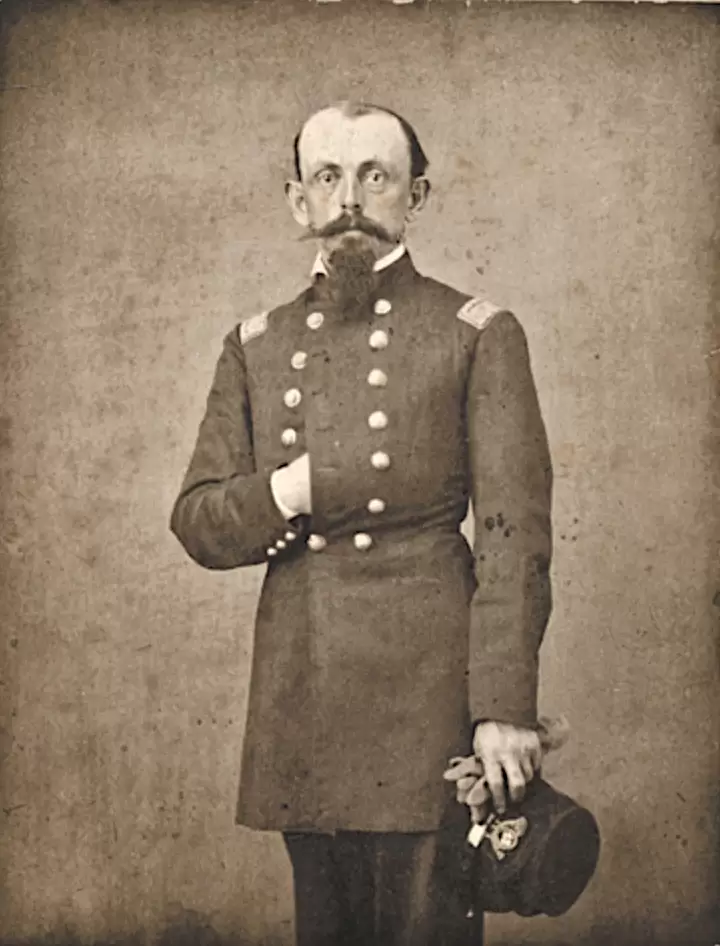
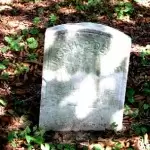
DENICKE (or DENIKE), JOSEPH P. (or C.) (1841-1871). First lieutenant, 5th Independent Battery, New York Light Artillery. A New York native, Denicke enlisted at Brooklyn as a private on August 15, 1861, and immediately mustered into the 5th Independent Battery, New York Light Artillery. He was promoted to second lieutenant on December 17, 1861, and subsequently to first lieutenant on June 5, 1863. Denicke resigned his commission on January 15, 1864. He last lived at 971 Fulton Avenue in Brooklyn. Maggie Denicke applied for and was granted a widow’s pension in 1890, certificate 331,196. A government-issued gravestone, installed circa 1900, marks his grave. Section 186, lot 29608.
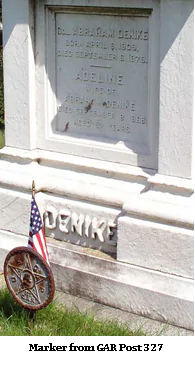
DENIKE, ABRAHAM (or ABRAM) (1809-1879). Lieutenant colonel, 53rd New York Infantry; captain, 5th New York Infantry, Company G. He was born in New York City into a family of some of the early settlers from Antwerp, Holland. The Denikes owned a large estate in the City before the American Revolution, but ultimately lost the paperwork that gave them title to the property. As a young man, Denike was apprenticed to a spar-maker but after a disagreement, went off to start his own ship-building business. He is listed as a spar-maker in the 1836 Longworth’s American Almanac for New York City, as a shipwright in that directory for 1838 and as a spar-maker in the 1843-1844 New York City Directory. The New York Times reported on January 17, 1856, that he was a member of the Finance Committee of the Board of Education.
The uncle of Abraham (see) and Charles (see), he served for 30 years before the War in the 27th New York Militia and then the 7th Regiment’s Company G rising to captain in the latter. By the time the Civil War began, he had retired from the ship-making business with a fortune. Though his wife urged him not to serve, saying that his first duty was to his family, he answered that his first duty was to God, then his country, and then his family.
Denike enlisted on April 25, 1861, at New York City, as a captain in the 5th New York as its oldest officer. He served under General Benjamin Butler and fought at the Battle of Big Bethel, Virginia, where he was the senior captain. Resigning on September 6, 1861, after he was passed over by a younger officer for major, he helped to raise the 53rd, re-enlisted as its major on June 6, 1862, at New York City, and was later promoted to lieutenant colonel. After his regiment was consolidated with others, he resigned on October 12, 1862.
After the War, he was director of the Dry Dock Savings Bank. His wife, Adeline, died in 1868. Remaining active in military affairs, he joined the 7th Veterans Regiment and was a member of the G.A.R. He was also a commissioner of education, treasurer of the Baptist City Mission, and president of the board of trustees of the Baptist Tabernacle in New York City. He last lived at 135 Lexington Avenue. According to his obituary in The New York Times his death was due to cardiac arrest. Denike, who had no immediate heirs, left $23,000 of his estate to religious and charitable institutions, a decision that was successfully contested by his nephews and a niece because the gift was made less than two months before his death. Section 111, lot 18157.
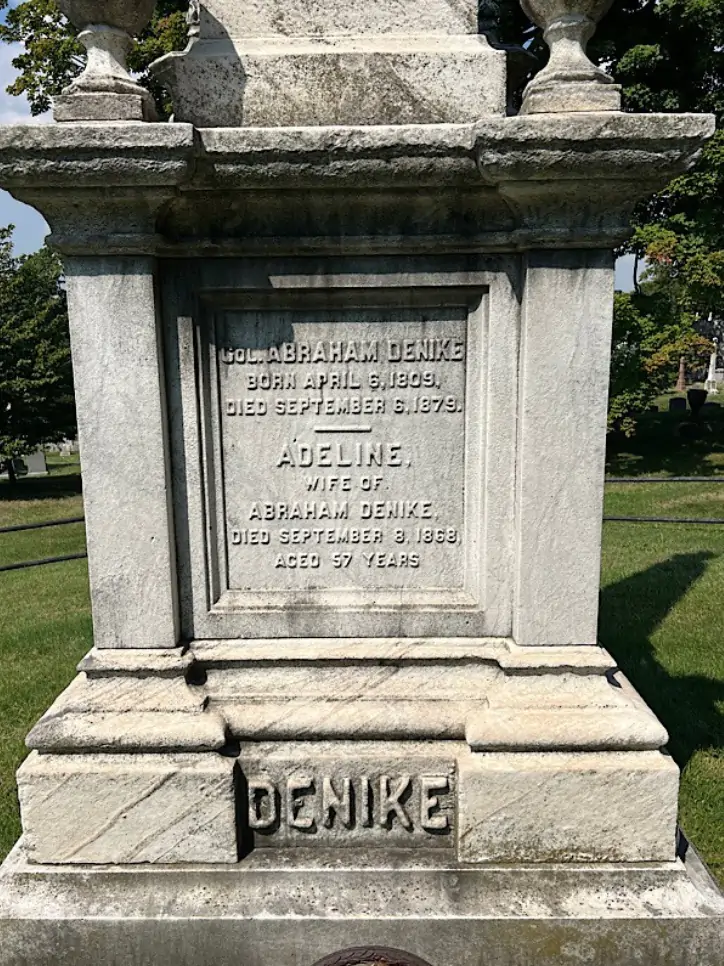
DENIKE, ABRAHAM (1840-1916). Corporal, 176th New York Infantry, Company I; private, 52ndRegiment, New York State National Guard. Born in New York City, Denike was the nephew of Abraham (see) and brother of Charles (see). The census of 1860 lists him as a seaman’s apprentice. He enlisted at Brooklyn on October 23, 1862, and mustered into the 52nd National Guard on that date. As per his muster roll, he was a blacksmith by trade who was 5′ 8½” tall with hazel eyes, brown hair and a fair complexion. He was transferred into the 176th on December 15, 1862, taken prisoner on June 24, 1863, at Bayou Boeuf, Louisiana, and was returned on August 17, 1863, by order of Major General Banks. At some point he was promoted to corporal before he mustered out at New York City on November 16, 1863.
The 1880 census notes that he was a policeman. In 1888, after his mother died, he sued his brother Charles, who lived with her, for one-third of her estate; the judgment was reached in Abraham’s favor in 1895. In 1890, his application for an invalid pension was granted under certificate 748,993. The censuses of 1900 and 1910 indicate that he was a real estate broker.
According to his obituary in the Brooklyn Daily Eagle, which confirms his Civil War service, Denike was in the real estate business and an active member of the Ulysses S. Grant Post #327 of the G.A.R. at which headquarters his funeral was held. Denike was a member of the Lafayette Avenue Presbyterian Church. He last lived at 424 Cumberland Street in Brooklyn. His death was attributed to apoplexy. Antoinette Denike applied for and received a widow’s pension in 1916, certificate 822,217. He was also survived by two daughters. Section 111, lot 18157.
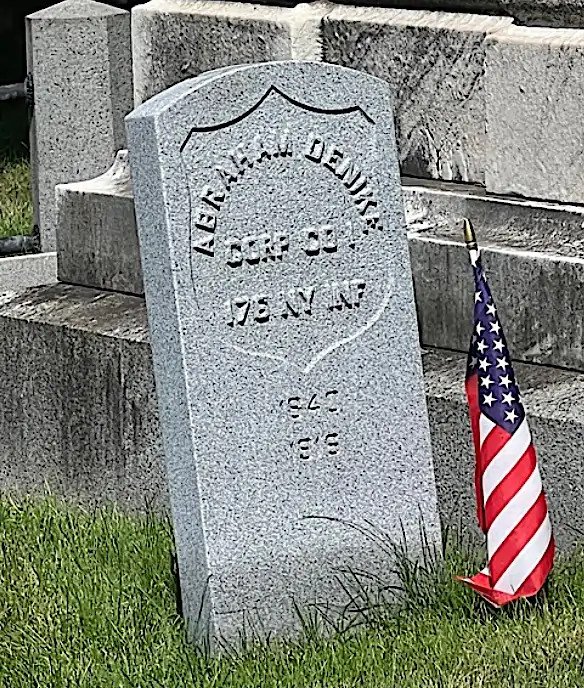
DENIKE, CHARLES W. (1842-1925). Private, 13th Regiment, New York State National Guard, Company B. Born in New York, Denike was a clerk as per the census of 1860. He enlisted at Brooklyn on May 28, 1862, mustered immediately into the 13th, and mustered out after three months at Brooklyn on September 12. He also served in Company C of the 37th Regiment, New York State Militia.
According to the census of 1870, he was a painter; the census of 1880 indicates that he was a house agent. In 1895, a judgment was handed down in the lawsuit in which he was sued by his brother Abraham for one-third of his mother’s estate; the court ruled in Abraham’s favor but the original assets of approximately $1,500 in 1888 were almost all gone by then. The 1900 census notes that Denike was a realtor. In 1904, he received an invalid pension, certificate 1,095,209. The 1924 List of Registered Voters in New York City identifies him as living at 2790 Broadway, his last address. His uncle, Abraham Denike (see), and brother, Abraham (see), also served in the War. He last lived in Manhattan at 2790 Broadway. His death was caused by cardiac arrest. Section 111, lot 18157.
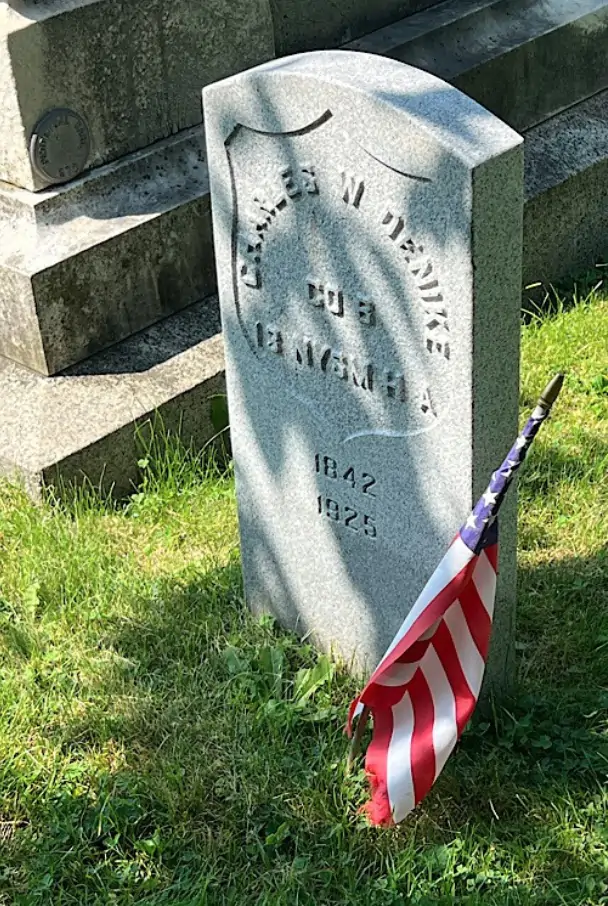
DENNIN, CHARLES (1840-1905). Pharmacist and member of the National Sanitary Commission. Dennin was born in Buffalo, New York, and moved to New York City when he was seven years old.. According to his obituaries in The New York Times and the Brooklyn Daily Eagle, he served as apothecary on the Ocean Queen, a ship outfitted by Commodore Vanderbilt, and chartered by the War Department at a cost of $2,000 a day during the Civil War to transport troops for a year, starting in October 1861. However, on one voyage, the Ocean Queen transported sick and wounded soldiers from Yorktown, Virginia, to New York City in May 1862, as part of the work of the Sanitary Commission, of which Dennin was a member. The National Sanitary Commission was an organization devoted to improving the medical care and addressing the emotional needs of soldiers in the field and in military hospitals. He was appointed as the chief apothecary at Bellevue Hospital and was commended by Secretary of War Edwin M. Stanton and Secretary of the Navy Gideon Welles for the manner in which he executed his duties during wartime.
In 1865, after the Civil War, he opened his own drugstore in South Brooklyn in 1865, first on Sackett Street, and then, two years later on the corner of Court Street and 1st Place, where he stayed in business for the rest of his life. Dennin is listed as a druggist in the 1867-1870, 1873-1876, 1880-1882, and 1884-1886 Brooklyn Directories. A prominent druggist and charter member of the Kings County Pharmaceutical Society, he was one of the founders of the Brooklyn College of Pharmacy and served as its treasurer at some point. In addition, he was a member of the New York State Pharmaceutical Society and the American Pharmaceutical Society.
Dennin’s obituary in the Brooklyn Daily Eagle states that he was beloved for his generosity and charity, giving hundreds of poor families free treatment and medication. He was also a personal friend of the Reverend Henry Ward Beecher (see) and President Grover Cleveland. He last lived at the same address as his pharmacy. His death was attributed to pneumonia. As per his obituary in the New York Herald, his funeral took place at the South Congregational Church, at the corner of President and Court Streets. Grace Dennin, his widow, and three sons survived him. Section 153, lot 19377.

DENNISON, GEORGE AMBROSE (1846-1929). Private, 7th New York Heavy Artillery, Company C. Born in Cooperstown New York, although one document says New York City, Dennison enlisted as a private at New York City on May 27, 1864, and mustered immediately into the 7th New York Heavy Artillery. He mustered out at Fort Federal Hill at Baltimore, Maryland, on June 16, 1865.
As per the Brooklyn Directory of 1871, he was a clerk living at 130 Ryerson Street. The 1900 census indicates that he was a wholesale stationer. In 1908, Dennison applied for and received an invalid pension, certificate 1,150,928. His obituary in the Brooklyn Daily Eagle, which confirms his Civil War service, notes that for 25 years he held an important position in the accounting Department of the New York Life Insurance Company and that he had been in failing health for a number of years. Dennison last lived at 134 Monroe Street in Brooklyn; he had been a Brooklyn resident for 50 years. He was cremated at Fresh Pond, New York, on January 5, 1929, and his remains were buried at Green-Wood on January 14. Louise Dennison applied for and received a widow’s pension in 1929, certificate a-4-11-29. Section 147, lot 24618.
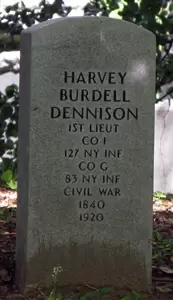
DENNISON (or DENISON), HARVEY BURDELL (1840-1920). First lieutenant, 127th New York Infantry, Company I; private, 83rd New York Infantry, Company G. Dennison was a native of New York. After enlisting as a private at New York City on May 27, 1861, he mustered immediately into the 83rd, and was discharged for promotion on August 27, 1862. He was commissioned into the 127th as a first lieutenant on September 1, 1862, and dismissed for disability on March 31, 1864. The disability discharge was removed on August 31, 1866.
It is possible that he is the Harvey Dennison who is listed as working in clothes-wringers in the 1868 Brooklyn Directory. The 1870 census indicates that Dennison was a store clerk whose personal property was valued at $1,000; according to the 1880 census, he was a clerk at the Navy Yard. Remaining active in military affairs, he was an aide-de-camp of Mallory Post #84 of the G.A.R. and a member of the 9th Veterans’ Association. The 1890 Veterans Schedule confirms his Civil War service. Although his applied for an invalid pension in 1890, application 894,270, it was never certified. As per a document from the War Department dated August 18, 1891, a dismissal for disability is equivalent to an honorable discharge. According to an article in the New York Herald on June 18, 1896, he was present at a meeting of Brooklyn War Veterans who sought to protect veterans in the workplace. His first wife, Elizabeth Gibson Dennison, died in 1910. He last lived at 185 State Street in Brooklyn. He succumbed to cardiac arrest. In 1926, his wife applied for a widow’s pension, application 1,241,391, but that request was never certified. Section 118, lot 4.
De NOBRIGA, JOHN BAPTISTE (1833-1905). Unknown rank, United States Navy. De Nobriga was born on the island of Madeira, Portugal, and immigrated to the United States in 1850. He married Mary Smith in 1855 and became a naturalized citizen in 1860. His obituary in the Brooklyn Daily Eagle notes that he was a resident of Brooklyn for 60 years. As per that obituary, during the Civil War he served in the United States Navy. According to dreaft registration information, compiled in 1863, was a 33-year-old mariner of Portuguese birth.
De Nobriga continued his life at sea after the Civil War. He is listed on the United States Naval Rendezvous records of March 1876 as having enlisted that month for a one-year term as a landsman and having sailed on the New Hampshire. That listing notes that he had previously served three years in the Navy and records that he was a cook who was 5′ 5½” tall with brown eyes, dark brown hair, dark complexion and a scar on his knee. As per the 1880 census, he was living at 43 Clermont Avenue in Brooklyn with his wife Mary and three children: Mary, age 15, Frank, age 11, and Emma, age 9. At the time of that census, John was working as a laborer. In 1885, as per Naval registers, he is recorded as a laborer at the Brooklyn Navy Yard earning $2.26 per day. He is noted as a veteran in the 1890 federal census schedules; however, that record mistakenly notes that he served in the United States Army.
On February 25, 1893, the Brooklyn Citizen reported that Emma De Nobrega (John’s daughter) married Albert Klingman, prominent in military circles and in Republican politics, at the bride’s home at 31 Lexington Avenue. The house was decorated with palms and fragrant flowers and the ceremony was conducted by Reverend Dr. Baker of the Church of the Messiah to which the bride’s family belonged. The bride’s veil was adorned with a diamond pin, a gift of the groom. On October 20, 1893, the Brooklyn Citizen reported on the marriage of Rose De Nobriga (identified as Mary on an online family tree and in the 1880 census) to Charles Hathaway. Reverend Dr. Baker officiated at the bride’s home; Frank, the bride’s brother, was best man. The bride’s gown was white silk trimmed with lace and satin ribbon.
The 1899 Brooklyn Directory lists John De Nobrega as a clerk living at 434 Gates Avenue. The 1900 census lists him as a naturalized citizen living with his wife of 45 years at 335 Lafayette Avenue in Brooklyn and working as a clerk at the Brooklyn Navy Yard. The 1905 census reports that he was living in Brooklyn with his daughter Mary and her husband, Charles Hathaway. Among the organizations in which De Nobriga was a member include the Rankin Post #10 of the G. A. R., the Freemasons and the Church of the Messiah, a Protest Episcopalian institution. As per his obituary in the Brooklyn Daily Eagle, he died at 335 Lafayette Avenue in Brooklyn of pneumonia. That obituary notes that he had been in Madeira that month where he contracted a heavy cold on the voyage. John’s name is on the manifest of passengers arriving in New York on the Peninsular on September 1, 1905; he had $10 in his possession and listed the Hathaways as his relatives in the United States. He had traveled there for pleasure with his close friend, Adelina Ferrara, Consul for Portugal in New York City. His funeral services were held at the Church of the Messiah, preceded by Grand Army and Masonic services at his home. A widower, he was survived by two married daughters and a son; his wife died in 1904. Probate records indicate that he was a widower with a son, Francis (Frank) and daughter, Emma. His daughter, Mary, with whom he last lived, is not listed on that document. Section 59, lot 1821.
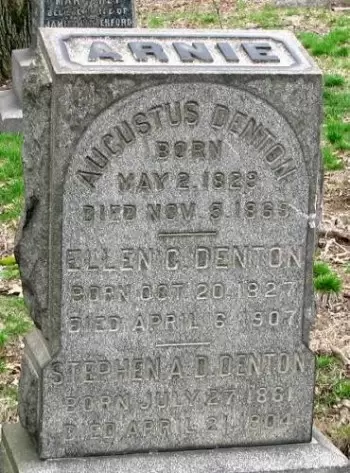
DENTON, AUGUSTUS (1829-1869). Private, 133rd New York Infantry, Company C. A New York State native, Denton was a land merchant according to the census of 1860 but listed his occupation as carman on his muster roll. He enlisted as a private at New York City on August 23, 1862, and mustered into the 133rd on September 24. He was 5′ 6½” tall with blue eyes, brown hair and a dark complexion. Denton mustered out with his company on June 6, 1865, at Washington, D.C. His death was attributed to phthisis. Within days of his death he was interred at Green-Wood in lot 4073; his remains were reinterred in lot 20066 two years after his death. In 1876, Ellen C. Denton, whose name is listed with his on the tombstone, applied for and received a widow’s pension, certificate 180,724. Section L, lot 20066.
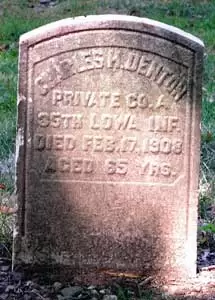
DENTON, CHARLES H. (1843-1908). Private, 35th Iowa Infantry, Company A; Veteran Reserve Corps. A New Yorker by birth, Denton was a resident of Muscatine, Iowa, when he enlisted as a private on August 2, 1862. He mustered into the 35th Iowa on August 29, and was transferred to the Veteran Reserve Corps on November 20, 1863. Denton mustered out at Davenport, Iowa, on June 27, 1865.
In the 1873-1876 Brooklyn Directory, he was listed in the hardware business and living at 457 Kent Avenue; the 1890 Brooklyn Directory lists him as a clerk. The Veterans Schedule for 1890 confirms his Civil War service. In 1892, his application for an invalid pension was approved, certificate 1,045,888. A member of Moses Odell Post #443 of the G.A.R., he was installed as its quartermaster sergeant in 1899. As per the census of 1900, he was a clerk in a hardware store. Denton died of heart disease. Section 14, lot 6687.
DeNYSE, DeNYSE H. (1810-1872). Second lieutenant, 71st Regiment, New York State National Guard, Company D. A native of New York, he was a fruit dealer as per the census of 1850. He enlisted at age 51 at New York City on April 19, 1861, was commissioned into the 71st Regiment on May 3, and mustered out at New York City on July 31 of that year. He returned to his unit when it was reactivated the next year, and was commissioned in on May 28, 1862. An article in The New York Times on May 29, 1862, described how the men of the 71st gathered outside the 71st Armory to get their uniforms and supplies. The spirits were high, “…All were not only willing but anxious to go, and joyously awaited the hour of departure. It was not the mere excitement of the moment, for many had tasted the stern realities of war. It was the calm, determined, patriotic resolve of good and loyal citizens….” DeNyse mustered out with his company after three months on September 2 at New York City. Commissioned again on June 30, 1863, he mustered out on July 22, 1863, at New York City.
The 1869 New York City Directory lists him as a fruit dealer; the census of 1870 notes that he was a foreign fruit dealer. As per his obituary in the Brooklyn Daily Eagle, members of the Veterans Corps from the 71st Regiment were invited to attend his funeral. He last lived at 63 7th Street in Brooklyn. Section 45, lot 5271.
DENZLER, GEORGE BERNARD (1834-1902). Private, 9th Maryland Infantry, Company H. Born in Germany and a shoe maker as per the census of 1860, Denzler enlisted and mustered into the 9th Maryland as a private on August 10, 1863 for a period of six months. His soldier record indicates that he was captured on October 18, 1863, at Charles Town, West Virginia. His muster roll notes that he was absent and a prisoner of war in November and December of 1863. He mustered out at Baltimore, Maryland, on February 23, 1864. According to the 1870 census, he was a shoe maker; on the census of 1880, he is listed as a saloon keeper. He last resided at 288 12th Street in Brooklyn. His death was caused by cancer. Section 206, lot 21347, grave 466.
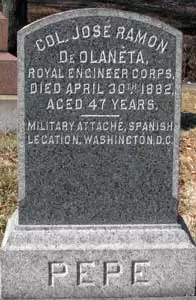
De OLANÈTA, JOSÉ RAMON (1835-1882). Military attaché from Spain and Union supporter. Colonel de Olanèta was the military attache of the Spanish Legation at Washington, D.C. A distinguished gathering attended his funeral mass at St. Patrick’s Cathedral in New York City. Among his pall-bearers were General Daniel E. Sickles, General John Watts de Peyster, and members of the Spanish military service. In recognition of his devotion to the cause of the Union during the Civil War while he was on duty in the United States as the military agent of Spain, the Secretary of War ordered Batteries M and A of the Fifth Artillery to act as an honor guard for the occasion. He died at the Windsor Hotel in New York City. Section 74, lot 11097.
DePEYSTER, RICHARD VARICK (1821-1874). Private, 44th Massachusetts Infantry, Company H. A native of New York City, DePeyster was 5′ 8″ tall with blue eyes, high forehead, Roman nose, prominent chin, light brown hair and complexion. Employed as a clerk, he gave up his job and left New York for Boston, Massachusetts, to volunteer for service. Rejected at first by the surgeons of the 24th and 44th Massachusetts because of near-sightedness, he made a bargain with Captain Smith of Company H of the 44th that he would serve without bounty or pay and would bankroll his own personal expenses. He enlisted at the age of 41 on August 29, 1862, and mustered into the 44th Massachusetts on September 12. He was wounded and lost his arm at Williamston, North Carolina, while acting as a stretcher-bearer, and mustered out on June 18, 1863, at Readville, Massachusetts. The story of DePeyster’s patriotism was recounted in Massachusetts Sailors, Soldiers, and Marines in the Civil War: The Medical and Surgical History of the Civil War. In 1870, he applied for and was granted an invalid pension, certificate 107,849. He last lived at the Remsen House on 130th Street in Manhattan. He died of heart disease. Section 11, lot 3921.
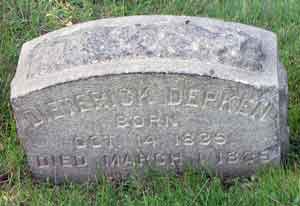
DEPKEN, DIEBRICK (or DIEDRICH, DIETRICH) (1835-1889). Private, 20th New York Infantry, Company G; 191st New York Infantry, Company A. A native of Bremen, Germany, Depken enlisted as a private at New York City on September 8, 1861, and mustered into the 20th New York. As per his muster roll, he was tried and convicted by the general court-martial for mutiny and misbehavior before the enemy (no date given) and sentenced to be dishonorably discharged. However, that sentence was overturned, he was restored to duty in April 1863 and was honorably mustered out on June 1, 1863. On February 8, 1865, he re-enlisted as a private at Tarrytown, New York, mustered into the 191st New York, and mustered out on May 3, 1865, at Hart’s Island, New York Harbor. According to his pension record, he also served in Company E of the 6th New York but there are no details.
As per the New York City Directory for 1875 and the 1880 census, he was a cigar-maker. He applied for an invalid pension in 1888, application 671,538, but he apparently died before it was certified. His last residence was 283 Broome Street in Manhattan. Depken’s death was caused by meningitis. Theresa Depken, who is interred with him, applied for and was awarded a widow’s pension after his death in 1889, certificate 323,974. Section 6, lot 20118, grave 38.
DEPKEN, HENRY (1829-1877). Private, 17th Pennsylvania Cavalry, Company I; 2nd Pennsylvania Provisional Cavalry, Company I. Born in Germany, Depken enlisted as a private on October 12, 1864, at Reading, Pennsylvania, and immediately mustered into the 17th Pennsylvania Cavalry. On June 17, 1865, he transferred into the 2nd Pennsylvania Provisional Cavalry, as a private, at Washington, D.C. He mustered out of military service on August 7, 1865, at Louisville, Kentucky. His last address was in Reading, Pennsylvania. The cause of his death was listed as dissipation and exposure. Section 77, lot 20060.
DERBYSHIRE, THOMAS (1830-1916). Landsman, United States Navy. Derbyshire, a native of Manchester, England, immigrated to the United States in 1863. He enlisted as a landsman at the Brooklyn Navy Yard on August 30, 1864, was assigned to the USS North Carolina, and participated in the Potomac Rescue Flotilla. On June 15, 1865, he was discharged at the Washington Navy Yard.
He applied for and became a naturalized United States citizen in 1876. Derbyshire is listed as a machinist in the 1870-1873, 1873-1876, 1880-1882, and 1888-1890 Brooklyn Directories. In 1891, he applied for and received an invalid pension from the United States Navy, certificate 18,802. He was living in Brooklyn at the time of the 1900 and 1910 censuses.
At the time Derbyshire applied for a total disability pension on March 20, 1905, and on February 3, 1914, he had been a core-maker in a foundry but was unable to work. He was 5′ 8½” tall and 145 pounds with brown eyes, white hair, fair complexion, tattoo marks on each arm and a scar on his nose. He indicated that he suffered from debility due to age, loss of vision, deafness (unable to hear unless someone shouted in his ear), and rigidity of joints. His pension applications are signed with an “X,” indicating that he was illiterate. As per his obituary in The New York Times, he was a veteran of the Civil War, who was survived by seven sons and three daughters. His death certificate states that he was a core-maker. He last lived at 50 Mills Street in Brooklyn. Section 128, lot 12807.
DEROFF (or DEROF), JACOB (1842-1890). Private, 45th New York Infantry, Company A; 58th New York Infantry, Company A. Deroff was born in Prussia. After enlisting as a private at New York City on October 7, 1861, he mustered into Company A of the 45th New York on that same day. His muster roll reports that he was a baker who was 5′ 5″ tall with blue eyes, light hair and a light complexion. Deroff re-enlisted at Lookout Valley on January 4, 1864, was transferred into Company A of the 58th New York on June 30, 1865, and mustered out on October 1, 1865, at Nashville, Tennessee.
As per the census of 1870, he was single, lived in Manhattan and was employed as a baker. It is possible that he is the Jacob Deroff who is listed as a laborer in the 1882-1883 New York City Directory. The Veterans Schedule of 1890 confirms his service in the 45th New York; at that time, he lived at 86 Cannon Street in Manhattan, which was his last residence. On August 1, 1890, he applied for an invalid pension but died before it was certified. His death was attributed to cirrhosis. On September 23, 1890, Johanna Deroff applied for and received a widow’s pension, certificate 335,952. Section 189, lot 18740.
DERRICKSON, JAMES GAUNT (1841-1866). Captain, 66th New York Infantry, Companies B and C. The son of a pioneering paper merchant, Derrickson attended the University of the City of New York, and entered service just out of college. He enlisted as a second lieutenant and mustered into Company B of the 66th New York in October 1861. His regiment engaged in actions in the Chickahominy swamps during the Battle of Fair Oaks and the Seven Days campaign in Virginia after which he was hospitalized for exposure at Camp Confidence. He was promoted to first lieutenant and adjutant of Company D of the 66th New York on August 18, 1862. The 66th fought at the Battle of Antietam, Maryland, September 17-19, 1862.
On December 16, 1862, Derrickson wrote the battle report from Falmouth, Virginia, about the devastating loss to the regiment at Fredericksburg, Virginia, “…The gaps in our ranks, caused by the combined fire of the enemy’s artillery and infantry, were quietly and quickly closed up, and the regiment advanced steadily to its work, and only when out of ammunition did it retire…The loss in the actions of December 11 and 13 was 75, and among these 6 commissioned officers, 5 of whom were the senior officers of the regiment. In consequence of this severe loss in officers, I am unable to give a full report of the actions in which we were engaged, as I am unaware of the orders received by the several officers commanding the regiment.”
He was promoted to captain on December 30, 1862, transferred to the Field and Staff, and then transferred to Company C on March 8, 1863. His regiment engaged at the Battles of Chancellorsville, Virginia, and at Gettysburg, Pennsylvania. On July 3, 1863, Derrickson was promoted to Acting Division Ordnance Officer of for the First Division, Second Corps of the Army of the Potomac. He held this position until he was captured at Petersburg, Virginia, on June 22, 1864. First held at the infamous Libby Prison in Richmond, Virginia, he also spent time in prisons at Macon, Georgia, and Columbia, South Carolina. His Civil War diary, which was serialized in nine parts by his nephew, Chauncey K. Buchanan, and published in The Argus, a newspaper in Tarrytown, New York (1890-1891), “Diary During My Imprisonment in Dixie.” describes Derrickson’s time as a prisoner of war focusing on food, shelter, sickness, morale, rumors, prayer meetings and sermons and treatment by the rebels. The period covered by the diary is June 22, 1864 through June 22, 1865, and includes comparisons of the prisons where he was held. Derrickson, an officer, was allowed access to newspapers while in prison and could send and receive mail. He was paroled on March 15, 1865, at an unknown location, and mustered out on May 15, 1865.
After the war, he was employed as an inspector at his father’s company and drowned in a work-related accident when a walkway broke in a paper plant he was examining in Stockport, New York, on October 13, 1866. His serialized diary entries are held at the William Clements Manuscript Library at the University of Michigan. His original diary is at the New York State Historical Association Library. Section 56, lot 5844.
DERRY, WALTER H. (1841-1895). Private, 11th New York Infantry, Company K; 71st Regiment, New York State National Guard, Company H. According to the census of 1860, Derry was a printer by trade. After enlisting as a private at New York City on April 20, 1861, he mustered into the 11th New York on May 7, and mustered out at New York City on June 2, 1862. Subsequently, he served for 30 days in 1863 in the 71st New York State National Guard.
The Brooklyn Directory for 1884-1885 indicates that he was a printer. He applied for an invalid pension in 1892, application 1,136,726, but there is no evidence that it was certified. Derry’s last address was 42 East 5th Street in Brooklyn. Derry succumbed to nephritis. His widow, Olive Derry, received a pension in 1895, certificate 426,682. Section 142, lot 22346, grave 3.
De RUYTER, CHARLES (1839-1890). Private, 7th Regiment, New York State Militia, Company J. De Ruyter, who was born in New York State where his family had long-time roots, was educated at Columbia College. He enlisted at New York City as a private in 1861 and served with the 7th Regiment for its activation of 30 days that year. He received a law degree from Columbia in 1862.
After the war, he resided in New Orleans for about 25 years where he was involved in the commercial trades and foreign exchange. As per his passport application of 1889, he was 5′ 10″ tall with hazel eyes, graying hair, a prominent nose, round face and florid complexion. His last address was in New Orleans, Louisiana, where he was a broker at 398 Magazine Street. According to his obituary, he was a member of the Chess, Checkers, and Whist Club where he suffered a stroke that resulted in his death. Section 43, lot 7670.
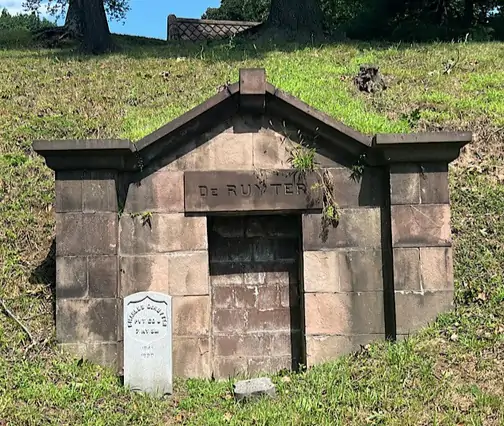
DeSAULLES, ARTHUR BRICE (1840-1917). Lieutenant, Engineers, Confederate States of America; private, 11th Louisiana Infantry, Company L. Born in New Orleans, Louisiana, and the brother of Henry (see), he was privately tutored there and then schooled in New England. He graduated from Rensselaer Polytechnic Institute with honors in 1859 where he studied geology. He was 5′ 8¾” tall with light hair and blue eyes. After touring Europe, and studying at the Ecole Des Mines in Paris, France, and in Germany, he returned to Louisiana in 1861, served with the 11th Louisiana as a private, received a bounty of $50 upon his enlistment, and served with the 11th Louisiana as a private. DeSaulles then entered the Engineer Corps as a lieutenant. Online biographies note that he achieved the rank of major in the Confederate Army.
In 1866, he came to New York where he was an engineer for the New York & Schuylkill Coal Company and was stationed in Wilkes-Barre, Pennsylvania, until 1871. From 1876-1883, he was superintendent of the Dunbar Furnace Company in Fayette County, Pennsylvania, and then headed the Oliphant Furnace Company in that county for five years. He subsequently was superintendent of the New Jersey Zinc Company in South Bethlehem, Pennsylvania, until 1911 and continued his interest in metallurgy throughout his life. He was a member of the Board of Trustees of St. Luke’s Hospital in Bethlehem, Pennsylvania, and president of the Men’s Club and vestryman at the Church of the Nativity there.
He was the father of Charles and John DeSaulles, both All-American football players and quarterbacks at Yale; he had another son and two daughters As per his online biography, his life was shattered when his son John, also known as Jack, was killed by his ex-daughter-in-law, a Chilean heiress, in Jack’s Mineola, Long Island, home in August 1917; Arthur DeSaulles and Jack’s two sisters were witnesses and testified at the murder trial. Anecdotally, the divorce trial in 1916 included testimony from Rudolph Valentino, who had an unspecified relationship with Jack’s wife. The murder trial was sensational; Blanca Errázuris, the divorced wife of Jack, had gone to the house, known as “The Box,” to seek custody of their son, and when Jack refused, she shot him five times. Ultimately, she was acquitted after declaring temporary insanity and arguing that her husband cheated on her, spent her inheritance and corrupted their son.
DeSaulles’s last residence was in Bethlehem, Pennsylvania, at 514 Delaware Avenue. His obituary in the Washington, D.C. Herald, which confirms his Civil War service, indicates that friends believed that he died from a broken heart; his death was attributed to cancer on other records. His obituary in the periodical, American Institute of Mining and Metallurgical Engineers, memorialized his contributions to the industry and to his hometown in Pennsylvania. His wife, Catherine Heckscher DeSaulles, whom he married in 1869, and four children, survived him. Section 77, lot 10262.
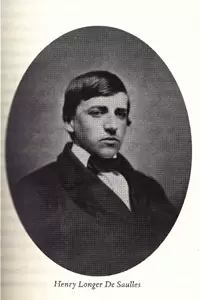
DeSAULLES, HENRY KONGES LONGER (or LOUGER) (1838-1863). First lieutenant, Miles’s Legion, Louisiana Infantry, Company F, Confederate States of America. DeSaulles was born in New Orleans, Louisiana, and was the brother of Arthur (see). His grandfather on his mother’s side fought in the Revolutionary War. In 1853, he came to Cambridge, Massachusetts, where he studied with a tutor before entering Harvard as a sophomore in 1854. After graduation in 1857, he took up commerce in New York, where his father settled, and then returned to Louisiana where he served in Miles’s Legion, Confederate States of America, enrolling as a second lieutenant by brevet on May 10, 1862, and rising to first lieutenant at some point.
His regiment fought at the Battle of Plains Store, Louisiana, on May 21, 1863, at which time its men defended a vulnerable position in a shallow ditch behind a barricade of rails covered with dirt. They shot their rifles and then shoveled out the trenches. That battle was part of the Union campaign to capture Port Hudson and close off a Confederate escape route.
Colonel William R. Miles, who commanded Miles’s Legion, was a personal friend of Henry DeSaulles, wrote to DeSaulles’s father (during the time when Miles was held as a prisoner) on August 22, 1863, “On his couch of death your son requested me to write to you concerning his fate. While at the head of his company, in the gallant discharge of his duty, he fell, mortally wounded, on the evening of the 3rd of June, 1863 [at Port Hudson, Louisiana]. The ball entered his right breast. He lingered until the night of the 4th, when he calmly passed away. I was with him most of the night of the 3rd; and at intervals, when sufficiently calm to converse, three subjects alone seemed to occupy his thoughts-his mother, his father, and his country. I cannot refrain from saying of your son, that a truer gentleman never lived, a braver soldier never died.” DeSaulles’s father later wrote that Henry’s remains were originally placed in a family fault in New Orleans and subsequently were moved to New York “and interred at Greenwood Cemetery, in a piece of ornamental ground, which I own there.” Interment at Green-Wood was on April 26, 1869. Section 45, lot 9460.
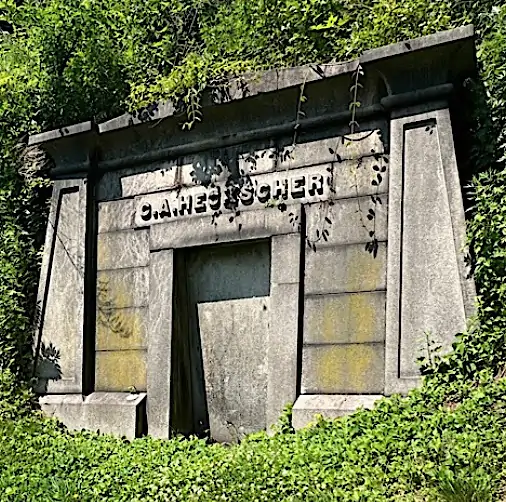
DeSHAY (or DESHAY), WILLIAM F. (1840-1876). Private, unknown Pennsylvania Regiment, Companies E and B; 12th United States Infantry, Company E. William was born in Pennsylvania to Anthony W. and Elizabeth Lyon DeShay. As per the 1850 and 1860 censuses, William lived in Danville, Pennsylvania.
During the Civil War, DeShay enlisted as a private at Danville and mustered into an unknown Pennsylvania regiment on August 3, 1861. Soldier records, which record his surname as Deshay, note that he served in Companies E and B and that he also served in the 12th Infantry, United States Army.
His online ancestry.com family tree shows that he married Elizabeth Letitia Westaway in New York City circa 1863. One of their children, William F. DeShay Jr. died from scarlatina on December 30, 1873, at the age of five years and one month. The youngster was buried at Green-Wood in lot 3330 on January 2, 1874.
On Tuesday evening, December 5, 1876, William, Elizabeth, and their daughter Annie attended a performance of the very popular The Two Orphans at the Brooklyn Theatre in downtown Brooklyn. As the performance proceeded, with over 1000 theatregoers in attendance, scenery caught fire and panic ensued. Intially it was thought that almost all had escaped, but it soon became apparent that the death toll was in the hundreds. Sadly, William, Elizabeth, and Annie all perished, three of the 278 who lost their lives that evening.
On December 8, the Brooklyn Daily Eagle reported on the identification of William DeShay in a piece entitled “A Tattooed Arm”:
In the midst of shrieks and sighs and sobs, in the gloom of the misty old market building [where a makeshift morgue had been set up], last evening, a woman rushed up to one of the officers on duty and demanded to be shown at once the body of William DeShay. She was daft with excitement. The officer—a kind hearted, considerate man—talked to her soothingly and told her the body had not been identified as far as he knew. Then the woman became calmer and began moving along the rows of corpses, uttering a melancholy croon and swaying her body to and fro. Suddenly she paused, and kneeling down by one of the bodies stripped the charred sleeve off the dead man’s arm. Then she sunk almost prostrate over the repulsive form. DeShad was identified. The form of a woman was tattooed in the flesh of the arm.
The remains of Elizabeth and Annie were never identified.
Arrangements were soon made for the interment of 103 of the victims of the fire at Green-Wood in a mass grave. These were people whose remains had not been identified or whose family could not affort their burial. As per the Brooklyn Times Union on December 9, 1876, De Shay was “[a]mong the bodies unclaimed and buried by the city in a common grave.” That newspaper also noted that DeShay had lived in Williamsburg and worked at Chapman’s Dock dredging Newtown Creek. The Brooklyn Daily Eagle reported on December 13, 1876, that relatives of victims of the fire were at the Coroner’s office to collect property found on the site of the fire; DeShay was named with the address of 771 Frost Street.
As per records of Surrogate’s Court, he left no wife or children and was survived by his brother, John L. DeShay and father, Anthony DeShay, both of whom resided in Pennsylvania; John applied on December 13, 1876 to be the administrator of the estate. Section N, lot 22427.
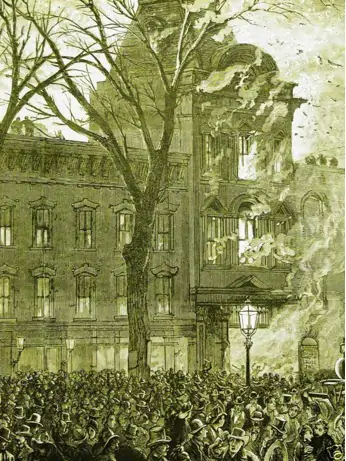
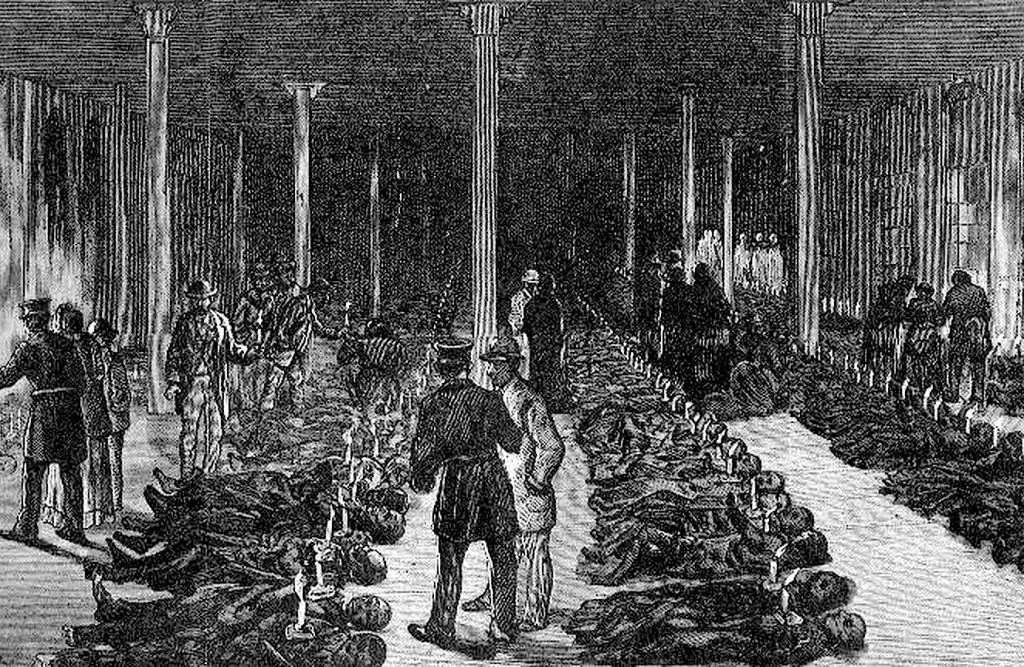
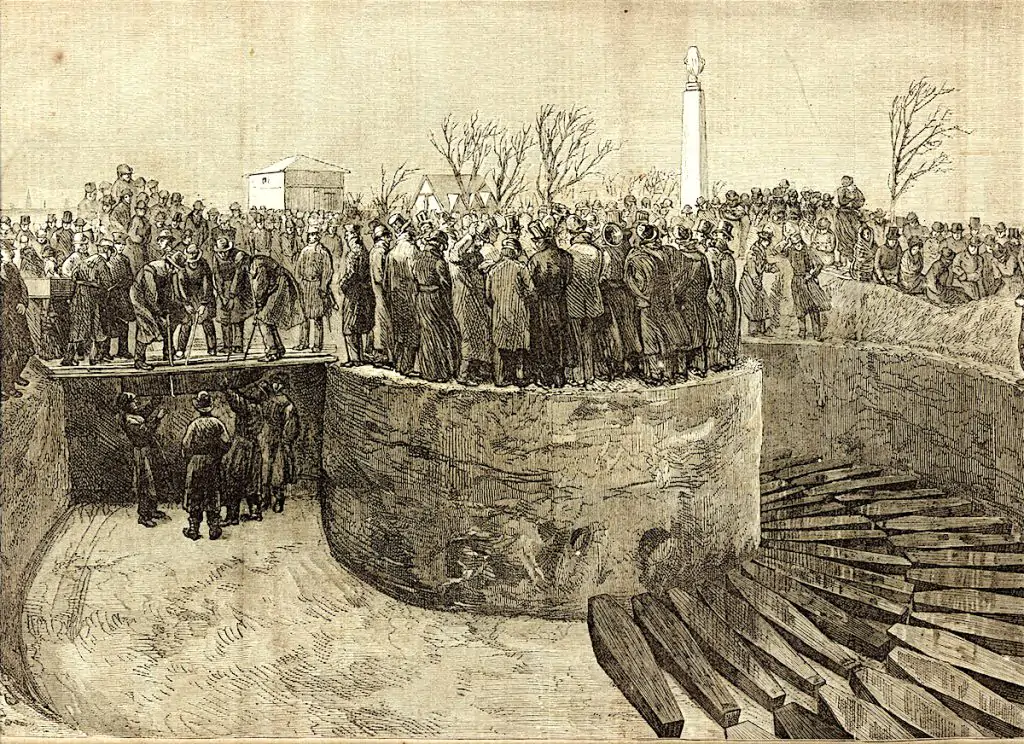
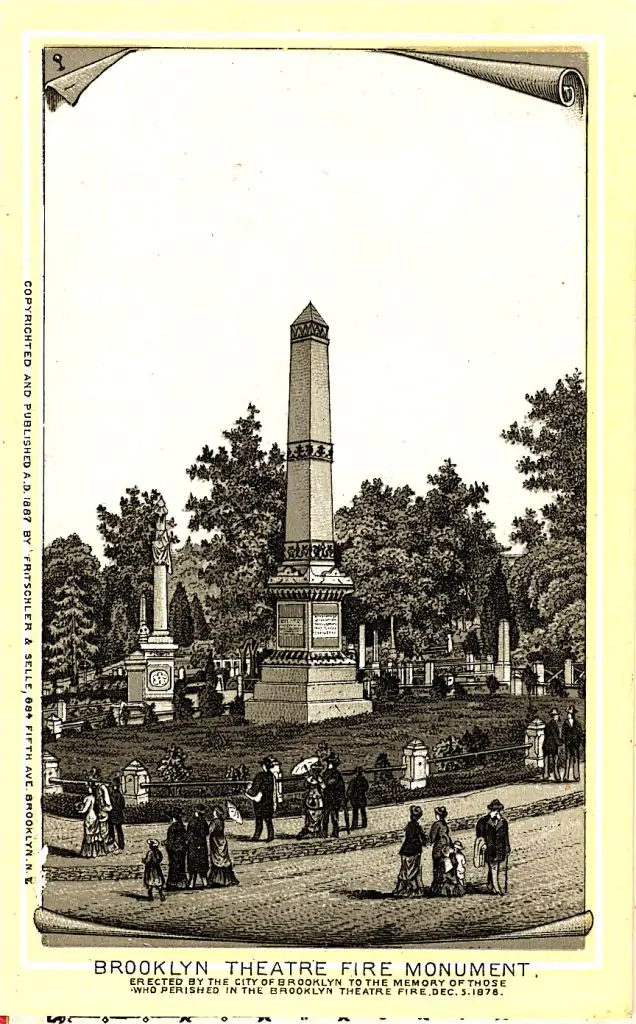
De SHAYS, HENRY (1831-1898). Private, 71st Regiment, New York State National Guard, Company G. De Shays was a native of New York City. After enlisting as a private at New York City on May 28, 1862, he mustered into the 71st Regiment that day, and mustered out three months later on September 2 at New York City. His last residence was 222 West 16th Street in Manhattan. The cause of death was phthisis. Section 135, lot 14964, grave 610.
DES MARETS, EMILE F. (1846-1932). Private, 37th Regiment, New York State National Guard, Company E. Born in Louisiana, he was the brother of Ernest Des Marets (see), a captain in the 37th Regiment. He served as a private for 30 days with the 37th Regiment in 1863.
As per the census of 1870, he was a gold broker; the 1875-1876 New York City Directory reports that he was a broker. Des Marets is listed in the 1876-1878 New York City Directory and the 1880 census as a purser. At the time he applied for a passport in 1886, he was 5′ 8″ tall with blue eyes, a long face, gray hair, and a moustache and beard. The 1890 Veterans Census indicates, “Traveling in Europe. Papers not available-wife gave no information.” According to the Brooklyn Directory of 1891-1892, he was living at 380 Halsey Street. The census of 1900 lists him as a representative. He reapplied for a passport in 1906; he no longer had a moustache and described his complexion as florid. On July 6, 1906, the New York Herald listed him as one of the tourists who had registered at the Herald office in Paris, France, during a summer of major travel; tourists registered at the office to notify friends and relatives of their arrival. Des Marets was elected to membership in the 71st Veterans’ Association in 1909. (In September 1870, the 37th Regiment was consolidated into the 71st Regiment.)
As per his obituary in the Daily Star, members of the 71st Veterans were invited to his funeral but the family requested no military honors. The obituary, which did not mention his Civil War service, stated that his military record included service in the Spanish-American War and the World War. He last lived at 42-36 158th Street in Flushing, Queens. Agnes Des Marets applied for a widow’s pension shortly after his death in 1932, application 1,723,486, but there is no certification number. His death was attributed to arteriosclerosis. Section 185, lot 23209.

DES MARETS, ERNEST A. (1842-1914). Captain, 37th Regiment, New York State National Guard, Company E. A native of New Orleans, Louisiana, Des Marets enlisted at New York City as a sergeant on May 29, 1862, mustered into the 37th National Guard that day, and mustered out on September 2 of that year. On June 24, 1863, he was commissioned into the same company as a second lieutenant, served 30 days, and mustered out at New York City on July 22, 1863. He was promoted to captain on May 6, 1864, was commissioned into the same company, and mustered out after 30 days on June 6 at New York City. His brother, Emile (see), also served in the 37th Regiment in 1863.
As per the 1874-1875 and the 1876-1878 New York City Directory, he was a broker at 6 Broadway. A stock broker in 1880 with offices at 58 Broadway in New York City, his company, Des Marets & Churchill, was a member of the New York Stock and Mining Exchanges. In 1905, he applied for and received an invalid pension, certificate 1,114,046. Active in civilian life, he was a Freemason and member of the Society of the Army of the Potomac and the George Washington Post #103 of the G.A.R. As per an article in the Brooklyn Daily Eagle on December 24, 1914, he died in Washington, D.C., after coming to the assistance of a boy who had been struck by a car. He, too, was struck and injured; he died of a fracture to his tibia a short time later. The article noted that Des Marets had a special interest in New York City waterways and was in the nation’s capital to attend the National Divers and Harbors Congress.
Among the many committees and organizations that he belonged to include: Committee on Waterways of the United Civic Organizations of Queens; Jamaica Bay Improvement Association; New York State and Long Island Waterways Associations; Queens County and Suffolk County Agricultural Education Associations; College Point Taxpayers; and the American Flag Association. An advocate for Flag Day, he was instrumental in starting the movement to make Flag Day a nationally recognized holiday. He died in Providence Hospital in Washington, D.C., but last resided in College Point, Queens. (He had lived in Speonk, Long Island, before relocating to College Point.) In May 1917, members of his G.A.R. Post presented a silk flag to St. Paul’s Chapel in College Point to honor his memory. His widow, Marie Louise Des Marets, received a pension in 1924, certificate 955,323. Section 98, lot 11288.
DESMOND, JOSEPH T. (1822-1871). Private, 2nd New York Heavy Artillery, Company G. Desmond was born in Philadelphia, Pennsylvania. He was a conductor, according to the 1857 New York City Directory; the census for 1860 lists him as a policeman with an estate valued at $300. During the Civil War, he enlisted as a private at New York City on August 8, 1862, and mustered into the 2nd New York Heavy Artillery on August 19. As per his muster roll, he was a stage driver who was 5′ 8″ tall with black eyes, black hair and a dark complexion. On May 30, 1865, he mustered out at Alexandria, Virginia. The census of 1870 indicates that he was a clerk. His pension record indicates service in Company E of the 54th Illinois Infantry but there is no further information related to that service. He last lived at 1110 2nd Avenue, Manhattan. He died of Bright’s disease. In 1886, Hannah Desmond, who is interred with him, applied for and received a widow’s pension, certificate 322,520. Section 22, lot 8934.
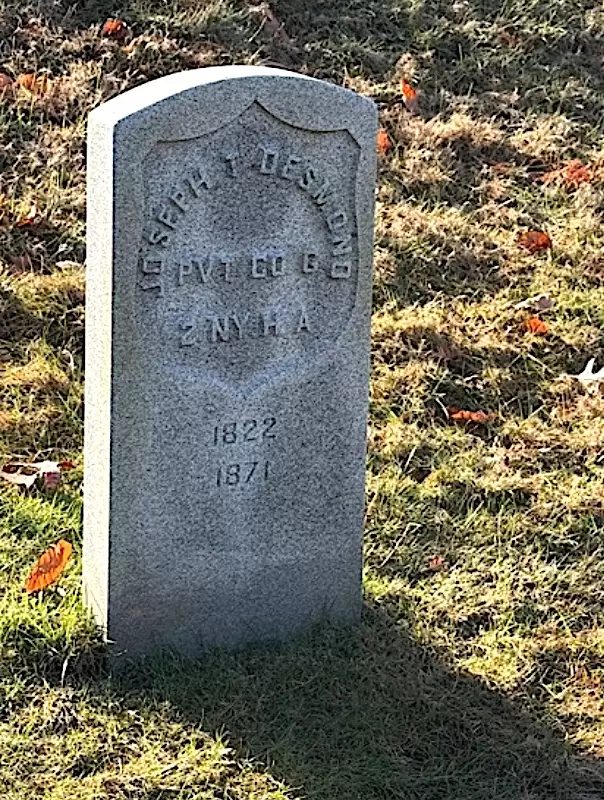
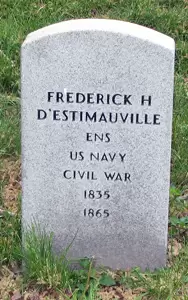
D’ESTIMAUVILLE (or D’ESTIMANVILLE), FREDERICK HENRIE (1835-1865). Ensign, United States Navy. Born in Quebec, Canada, in 1833, as per baptism records, his family immigrated to the United States in 1837. (Green-Wood records 1835 as his birth year.) The family lived in Philadelphia at some point. A Brooklyn resident, D’Estimauville served in the United States Navy during the Civil War. He enlisted on November 23, 1861, and was assigned to the USS Flambeau. According to an article in The New York Times on July 18, 1862, he was a captain’s clerk on the USS Flambeau when the vessel returned to Port Royal, South Carolina, after spending eight months in the Bahamas.
On January 31, 1863, D’Estimauville was part of a foraging party sent from the Flambeau to Bull’s Island, South Carolina, when they saw eleven uniformed Confederates come out of the plantation known as Gibbes’ Farm. D’Estimauville ran and eluded capture; two of the men were captured and another successfully fled back to the ship. The next day, D’Estimauville returned to the island as part of a small search party but after one in the group was shot and another killed, the mission was called off.
He was appointed acting ensign from the state of Pennsylvania on June 24, 1863, while attached to the Flambeau. He remained on that shipuntil February 20, 1864, when he was assigned to the USS Tecumseh as of February 26. A medical note dated April 25, 1864, states that D’Estimauville was treated for catarrh and “some derangement of the liver and bowels” which occurred in the line of duty aboard the Tecumseh and was fit to return to duty.
He became an ensign on October 13, 1864, at which time he was assigned to the USS Otsego. In October 1864, he was suffering from dysentery and ordered to report to the Norfolk Naval Hospital; however due to difficulty communicating with Norfolk and poor sanitation in Albemarle Sound (the outer banks of North Carolina), he was unable to go there and went to New York instead. Records indicate that he went to his father’s residence in November 1864 and wrote to Secretary of the Navy Gideon Welles requesting that his illness be treated in New York despite Welles’s order that he go to Norfolk. D’Estimauville’s father wrote to Welles that they would try to comply but that his son was paralyzed. Welles then ordered that D’Estimauville be treated at the Naval Hospital in New York as of December 17, 1864. His only daughter, Frederica Rebecca Jeanne, was born in Philadelphia three days later; he had married Rebecca Newbold Richardson on March 15, 1864. It was believed that his paralysis was caused by malaria contracted in Albemarle Sound. By February 9, 1865, he was able to raise his hands to his head. On February 19, he had a swollen throat. He asked to be discharged to his parents’ home to see his wife and newborn daughter but the surgeon refused saying that his wife said “he might as well die in the hospital as anywhere else.” Nonetheless, as per records of crew members of the Tecumseh, he attempted to go see his family but he was gasping for breath in a carriage that was taking him to his parents’ house and died before he could get back inside the hospital.
On February 23, 1865, records indicate that he died at the United States Naval Hospital in Brooklyn. Rebecca D’Estimauville, his widow, first sought a pension on April 12, 1865, testifying that her husband’s illness was contracted during his Naval service. According to a letter in his pension file dated July 14, 1865, a doctor testified that D’Estimauville was treated for croup caused by exposure on the USS Flambeau. His death certificate stated that he was admitted to the hospital on December 17, 1864, with partial paralysis, seemed to be recovering and independently left the hospital on February 19, 1865. The surgeon, who signed the certificate, stated that the illness did not occur in the line of duty. His widow asserted that he wanted to go home to his family to die and contested the comments on the death certificate. Her application was approved, certificate 1,760. In 1917, she reapplied for a widow’s pension under the name Rebecca Wyllie. He is listed as a graduate of the 14th class of Central High School of Philadelphia, a well-regarded academic public school as of 1836, in a book published in 1902; that school history states that he was deceased and served in the United States Navy. Section 72, lot 8333.
DE THULSTRUP, THURE (1848-1930). Artist and illustrator of Civil War battles. Born Bror Thure Thulstrup in Stockholm, Sweden, into a military family (his father was Swedish minister of war 1850-1861), he graduated from the National Military Academy there. In 1870, he went to Paris and became an officer in the French Foreign Legion. He served in Algeria and fought against Germany in 1871 during the Franco-Prussian War, rising to the rank of captain. In Paris he studied drawing, and immigrated to Canada in the early 1870s. He worked there and in New England as a topographical engineer, then settled in New York City in 1873, where he gained renown as an illustrator and studied at the Art Students League. He contributed to numerous magazines including the New York Daily Graphic, Harper’s Weekly (under the aegis of cartoonist Thomas Nast), Frank Leslie’s Illustrated Newspaper, Century and Scribner’s Magazine. In 1879, he married Lucie Bavoillot.
Thulstrup worked for Harper’s for thirty years. He painted scenes from American battles, including Pickett’s Charge at Gettysburg and other Civil War battles, two of which appear below. One of his publishers, Louis Prang, called him “the foremost military artist in America.” His work was known for its multitude of figures and extraordinary detail. His historical paintings of American colonial days, many of which illustrated the Virginian lifestyle, were reproduced and sold widely. He covered the inauguration of four Presidents and the funeral of President Grant for Harper’s, and traveled throughout Europe creating illustrations. An article in the New York Press on April 19, 1892, noted that a collection of his pictures were placed on view by Frederick Keppel & Company for the public before they were to be offered for private sale.
A prolific artist, his drawings appeared in Drawings by Thulstrup and Others (1898), Outdoor Pictures (1899), and Arthur Conan Doyle’s The Refugees (1893). In 1902, for the St. Louis World’s Fair, he was commissioned to paint Hoisting American Colors, Louisiana Cession, 1803, commemorating the Louisiana Purchase; that painting is now at the Louisiana State Museum. After his wife died in 1915, his eyesight began to fail and he spent the last nine years of his life at the Episcopal Home for Old Men and Aged Couples. He left no survivors. Some of his Civil War illustrations can be viewed in the Digital Collections of the Library of Congress. Section 147, lot 21897.
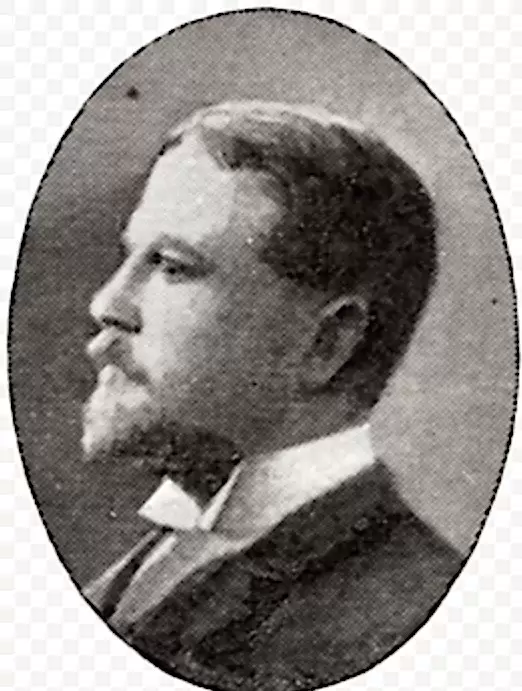
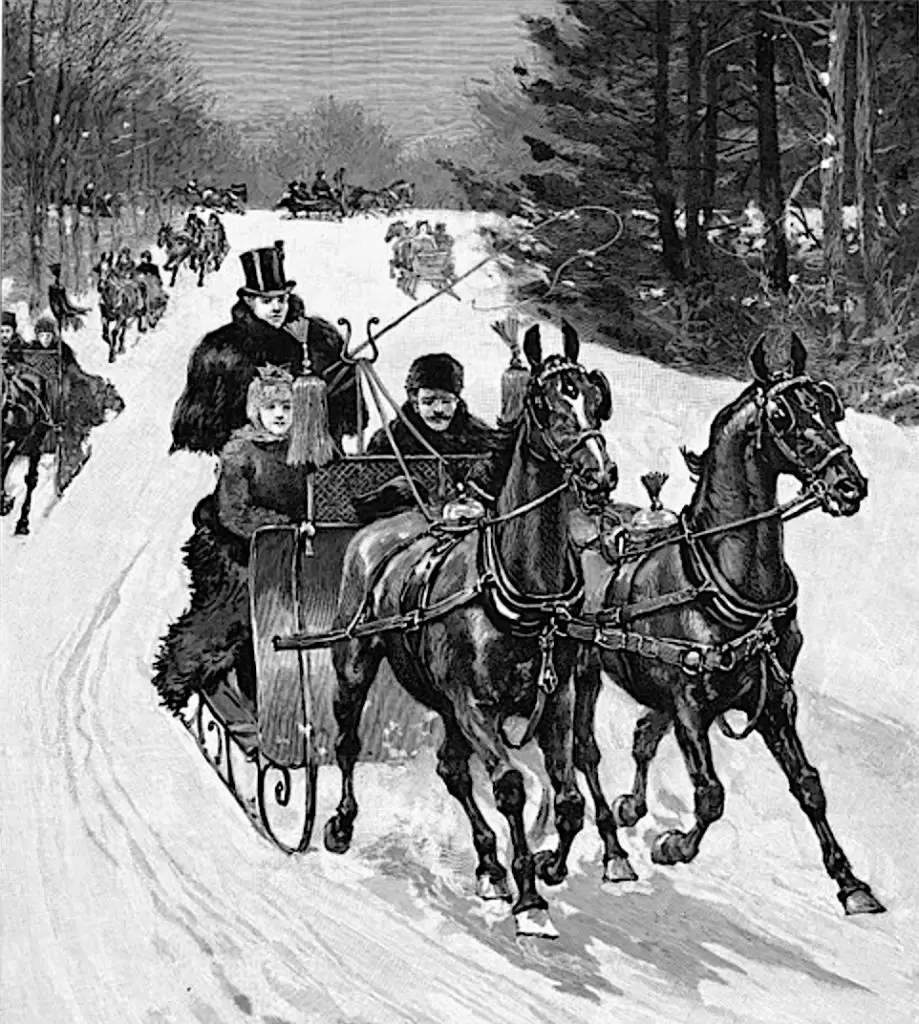
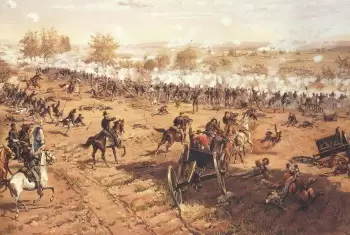
DETWEILER, LOUIS (or LEWIS) ADALBERT (1832-1907). Private, 56th Regiment, New York State National Guard, Company H. Of German origin and a bar keeper according to his draft registration, Detweiler served as a private with the 56th Regiment when it was activated in 1863 for 30 days. He became a naturalized citizen on February 27, 1864. As per the census of 1870, he was a tavern keeper. His last residence was 768 Third Avenue in Brooklyn. Detweiler died of bronchitis. Section B, lot 11005, grave 264.